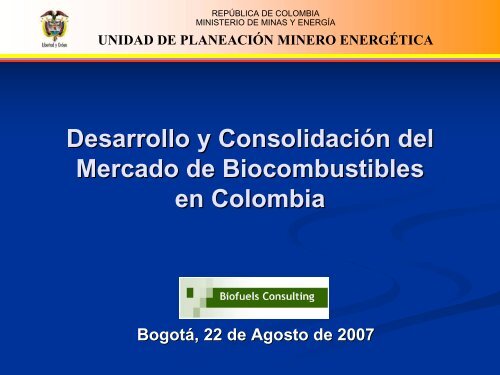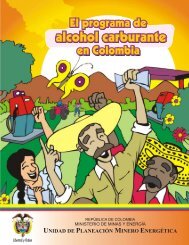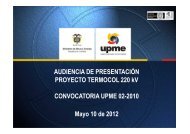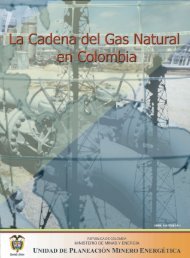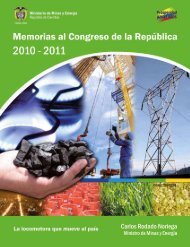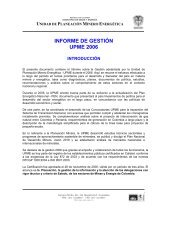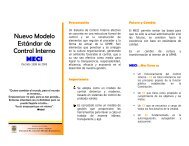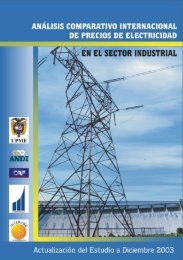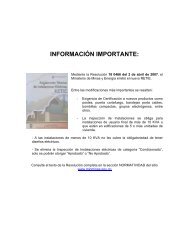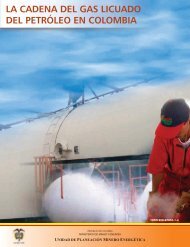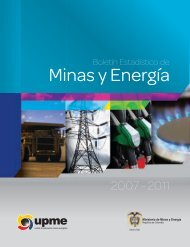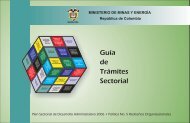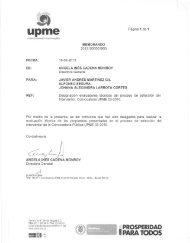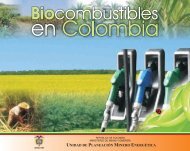Biodiesel - Unidad de Planeación Minero Energética, UPME
Biodiesel - Unidad de Planeación Minero Energética, UPME
Biodiesel - Unidad de Planeación Minero Energética, UPME
You also want an ePaper? Increase the reach of your titles
YUMPU automatically turns print PDFs into web optimized ePapers that Google loves.
REPÚBLICA DE COLOMBIA<br />
MINISTERIO DE MINAS Y ENERGÍA<br />
UNIDAD DE PLANEACIÓN MINERO ENERGÉTICA<br />
Desarrollo y Consolidación n <strong>de</strong>l<br />
Mercado <strong>de</strong> Biocombustibles<br />
en Colombia<br />
Bogotá, , 22 <strong>de</strong> Agosto <strong>de</strong> 2007
El Equipo (en el or<strong>de</strong>n <strong>de</strong> la presentación):<br />
n):<br />
• José Eddy Torres<br />
• Roberto Albán<br />
• Lesmes Corredor<br />
• Consuelo Ortiz<br />
• Félix Betancourt<br />
Director <strong>de</strong>l Proyecto<br />
Mercados y Normatividad<br />
Análisis Tecnológico<br />
Análisis Agronómico<br />
- SIG<br />
Portafolio <strong>de</strong> Proyectos –<br />
Mo<strong>de</strong>lo <strong>de</strong> Optimización
Contenido<br />
• Introducción<br />
• Mercados y Normatividad<br />
• Análisis Tecnológico<br />
• Análisis Agronómico<br />
- SIG<br />
• Análisis <strong>de</strong>l Portafolio <strong>de</strong> Proyectos<br />
• Conclusiones y Recomendaciones
Introducción
OBJETIVO<br />
Realizar un análisis comprensivo<br />
<strong>de</strong> las restricciones y oportunida<strong>de</strong>s<br />
estratégicas para el <strong>de</strong>sarrollo<br />
sustentable <strong>de</strong> la ca<strong>de</strong>na <strong>de</strong>l<br />
mercado <strong>de</strong> etanol combustible y el<br />
biodiesel en Colombia, para lo cual<br />
se abarcaron cuatro ejes temáticos:<br />
ticos:
EJES TEMÁTICOS<br />
TICOS<br />
MERCADOS<br />
NORMATIVIDAD<br />
ECONOMICO FINANCIERO<br />
TECNOLOGÍA<br />
MOTORES<br />
PLANTAS<br />
AGRONÓMICO<br />
AMBIENTAL<br />
SOCIOECONÓMICO<br />
PORTAFOLIO DE<br />
PROYECTOS<br />
SIG BFC – Áreas Potenciales Cultivos Promisorios<br />
Mo<strong>de</strong>lo BFC – Localización <strong>de</strong> Plantas
Iniciativas Años A<br />
70<br />
Iniciativas en los 70’s s para impulsar mezclas E20 :<br />
• Materia prima: caña a <strong>de</strong> azúcar, caña a panelera y yuca<br />
• + altos precios <strong>de</strong>l petróleo, fin autosuficiencia<br />
petrolera, abundancia tierras aptas, climas<br />
óptimos para cultivos, generación n empleo rural.<br />
• - bajo rendimiento producción n materia prima,<br />
inestabilidad <strong>de</strong> la mezcla, competencia <strong>de</strong>sigual<br />
“combustibles vs. comestibles”, , efectos<br />
ambientales, balance energético, Caño o Limón<br />
(1983) y Cusiana (1988).
Nueva Era <strong>de</strong> Biocombustibles<br />
difiere <strong>de</strong> los Años A<br />
70<br />
• Madurez tecnológica industria <strong>de</strong> biocombustibles,<br />
especialmente en etanol. Tecnología a <strong>de</strong> biodiesel<br />
también n avanza.<br />
• A la espera <strong>de</strong> biocombustibles <strong>de</strong> segunda<br />
generación n (celulósicos)<br />
• Atractivo económico: Protocolo <strong>de</strong> Kyoto / Cambio<br />
Climático<br />
- Precios internacionales <strong>de</strong>l petróleo<br />
• Por primera vez: oportunidad realista <strong>de</strong> sustitución<br />
<strong>de</strong> combustibles fósiles f<br />
a escalas masivas con<br />
fuentes renovables <strong>de</strong> energía, más m s allá <strong>de</strong> Brasil
¿Cómo estamos hoy en<br />
FACTORES A FAVOR<br />
Colombia?<br />
• Normatividad Etanol lista; <strong>Biodiesel</strong> casi lista<br />
• Estímulos Económicos<br />
• Fórmulas <strong>de</strong> precios atractivas<br />
• Incentivos tributarios<br />
• Líneas <strong>de</strong> Fomento<br />
• Régimen <strong>de</strong> zonas francas<br />
• Tierra más m s que suficiente sin conflicto uso
¿Cómo estamos hoy en<br />
FACTORES A FAVOR<br />
Colombia?<br />
Acciones nacionales en firme 2001-2007:<br />
2007:<br />
• Decisiones <strong>de</strong> fondo tomadas - sectores público p<br />
y privado<br />
• Gremios y sistema científico<br />
fico-tecnológico movilizados<br />
• Capitales nacionales vinculados al naciente sector<br />
• Ya se produce y distribuye E10 y se tiene primera planta<br />
montada para producción n <strong>de</strong> biodiesel
¿Cómo estamos hoy en<br />
Colombia?<br />
FACTORES LIMITANTES:<br />
• Mercado pequeño o y estructuralmente DECRECIENTE<br />
<strong>de</strong> gasolina y E10<br />
• Infraestructura y consumo <strong>de</strong> GNC creciendo tras<br />
<strong>de</strong>spegue lento – ¿flex-fuel fuel implica surtidores 100%<br />
biocombustible?<br />
• Mercado diesel en alza pero pequeño<br />
• Restricciones técnicas t cnicas para aumentar mezclas por<br />
encima <strong>de</strong> E10 y B5<br />
• El <strong>de</strong>sarrollo <strong>de</strong> la industria necesariamente tendría a que<br />
ser para exportación
¿Cómo estamos <strong>de</strong> Proyectos?<br />
• Casi 60 i<strong>de</strong>ntificados – muchos <strong>de</strong> promotores,<br />
pocos <strong>de</strong> inversionistas<br />
• 5 Destilerías operando – 1.050.000 L/d = 71%<br />
<strong>de</strong>l E10 <strong>de</strong>mandado hoy; 87% <strong>de</strong>l 2010; >90%<br />
<strong>de</strong> 2015<br />
• Oleoflores inaugurada – 50.000 t-a t – suficiente<br />
para B5 Costa sin carbón<br />
• Mercado interno <strong>de</strong> biocombustibles se satura<br />
con 2-32<br />
3 plantas adicionales
Análisis <strong>de</strong> Mercados,<br />
Aspectos Económicos y Financieros
Mercado Nacional<br />
• Mercado nacional para E-10 E<br />
pequeño o y<br />
estructuralmente <strong>de</strong>creciente<br />
• Mercado nacional para B-5 B 5 pequeño<br />
• Opciones :<br />
• Presionar incremento en mezcla, por ejemplo:<br />
E-20; B-10 B<br />
o mayores<br />
• Volcarse al mercado externo
Ventas <strong>de</strong> Gasolina y Diesel <strong>de</strong> Ecopetrol<br />
140<br />
120<br />
100<br />
80<br />
60<br />
40<br />
20<br />
0<br />
k b d<br />
1979<br />
1980<br />
1981<br />
1982<br />
1983<br />
1984<br />
1985<br />
1986<br />
1987<br />
1988<br />
1989<br />
1990<br />
1991<br />
1992<br />
1993<br />
1994<br />
1995<br />
1996<br />
1997<br />
1998<br />
1999<br />
2000<br />
2001<br />
2002<br />
2003<br />
2004<br />
2005<br />
2006<br />
2007 E-M<br />
Gasolina Diesel
Las Ten<strong>de</strong>ncias son Estructurales<br />
• Gasolina<br />
Motor:<br />
EVOLUCION DE LAS VENTAS DE GASOLINA MOTOR<br />
POR ESTACIONES DE SERVICIO 1996 - 2005<br />
Segmento Usuario GM 1996 GM 2005 Diferencia Cambio<br />
Taxis 23 288 13 767 -9 521 -41%<br />
Colectivo 22 719 1 439 -21 280 -94%<br />
Carga 19 439 14 008 -5 431 -28%<br />
Acuático 1 067 2 645 1 578 148%<br />
Tr. Particular 64 233 54 756 -9 477 -15%<br />
Auto generación 3 512 478 -3 034 -86%<br />
Otros Sectores 4 391 3 421 - 970 -22%<br />
Total via Estaciones 139 441 93 160 -46 281 -33%<br />
• Desaparición Transporte Colectivo GM<br />
• Renovación Segmento Taxis<br />
• Ajustes parque particular (motos, GNC en<br />
altos cilindrajes)
Las Ten<strong>de</strong>ncias son Estructurales<br />
• Diesel<br />
EVOLUCION DE LAS VENTAS DE DIESEL OIL POR<br />
ESTACIONES DE SERVICIO 1996 - 2005<br />
Segmento Usuario DO 96 DO 05 Cambio<br />
Taxis 213 844 631 296%<br />
Colectivo 8 155 19 379 11 224 138%<br />
Carga 28 955 31 977 3 022 10%<br />
Acuático 1 018 2 162 1 144 112%<br />
Tr. Particular 817 1 849 1 032 126%<br />
Auto generación 2 849 554 -2 295 -81%<br />
Otros Sectores 4 277 4 577 300 7%<br />
Total via Estaciones 46 443 63 503 17 060 37%<br />
• Mayor incremento en transporte colectivo: a<br />
más <strong>de</strong> 23.000 BPDC incluyendo gran<strong>de</strong>s<br />
consumidores (triplicó en la década)<br />
• Carga también significativa (>3.000 BPDC)
Mercado Lícito L<br />
<strong>de</strong> Gasolina y Diesel<br />
Ca<strong>de</strong>na Lícita L<br />
- 2006<br />
Bogotá Centro<br />
35%<br />
Mercado Lícito <strong>de</strong> Gasolina<br />
82 KBD<br />
Occi<strong>de</strong>nte<br />
16%<br />
Antioquia<br />
Chocó<br />
14%<br />
39.6 M-LtsM<br />
Lts/mes <strong>de</strong><br />
Etanol para E10<br />
Resto Frontera<br />
1%<br />
Guajira<br />
1%<br />
Santan<strong>de</strong>r<br />
6%<br />
Huila Tolima<br />
Sur<br />
6%<br />
Eje Cafetero<br />
8%<br />
Costa Atlántica<br />
13%<br />
Bogotá Centro<br />
26%<br />
Mercado Lícito <strong>de</strong> Diesel<br />
92 KBD<br />
Occi<strong>de</strong>nte<br />
13%<br />
Antioquia Chocó<br />
11%<br />
235 K-Ton/aK<br />
Ton/año o <strong>de</strong><br />
<strong>Biodiesel</strong> para B5<br />
Resto Frontera<br />
1%<br />
Cesar - Carbón<br />
5%<br />
Guajira<br />
6%<br />
Santan<strong>de</strong>r<br />
9%<br />
Huila Tolima Sur<br />
6%<br />
Eje Cafetero<br />
6%<br />
Costa Atlántica<br />
17%
Etanol - Ciuda<strong>de</strong>s Principales<br />
Ciuda<strong>de</strong>s<br />
Consumo Requerimiento<br />
Población Gasolina Etanol 10%<br />
(miles) Barriles/Día K-Lts/mes<br />
Bogotá 7,186 19,686 9,519<br />
Cali 2,423 7,115 3,440<br />
Me<strong>de</strong>llín 2,094 8,981 4,342<br />
Barranquilla 1,387 2,114 1,022<br />
Cartagena 1,030 1,449 701<br />
Cúcuta 743 164 79<br />
Pereira 522 1,222 591<br />
Bucaramanga 577 1,723 833<br />
Total 15,962 42,454 20,528<br />
% <strong>de</strong>l País 38% 52% 52%
Alcohol – Regiones Geográficas<br />
Regiones<br />
Consumo Requerimiento<br />
Gasolina Etanol 10%<br />
Barriles/Día K-Lts/mes<br />
Gasolina Oxigenada en 2007<br />
Bogotá - Centro 27,469 13,282<br />
Occi<strong>de</strong>nte 13,470 6,513<br />
Eje Cafetero 6,641 3,211<br />
Santan<strong>de</strong>r 5,197 2,513<br />
Total Gasolina Oxigenada 52,776 25,519<br />
Sin Gasolina Oxigenada<br />
Antioquia - Chocó 11,850 5,730<br />
Costa 11,153 5,393<br />
Huila - Tolima - Sur 5,301 2,563<br />
Resto <strong>de</strong>l País 805 389<br />
Total No Oxigenado 29,109 14,075<br />
Total Mercado Lícito 81,885 39,594
Proyecciones <strong>UPME</strong> 2007<br />
Escenario Base vs. Escenario Alto PIB GNV =Precios<br />
170<br />
150<br />
K B D<br />
130<br />
110<br />
90<br />
70<br />
50<br />
2005<br />
2006<br />
2007<br />
2008<br />
2009<br />
2010<br />
2011<br />
2012<br />
2013<br />
2014<br />
2015<br />
2016<br />
2017<br />
2018<br />
2019<br />
2020<br />
2021<br />
2022<br />
2023<br />
2024<br />
2025<br />
Diesel - Escenario Base<br />
Diesel - Escenario Alto PIB GNV =Precios<br />
Gasolina - Escenario Base<br />
Gasolina - Escenario Alto PIB GNV =Precios
2021<br />
45<br />
40<br />
35<br />
30<br />
25<br />
20<br />
Demanda <strong>de</strong> Alcohol Carburante en Colombia<br />
Para Mezclas E-10 (10% Etanol)<br />
2006<br />
2007<br />
2008<br />
2009<br />
2010<br />
2011<br />
2012<br />
2013<br />
2014<br />
2015<br />
2016<br />
2017<br />
2018<br />
2019<br />
2020<br />
Escenario Base Esc. Alto PIB - GNV - Precios<br />
M-Lts / Mes
3,000,000<br />
Evolución <strong>de</strong> la Producción y Ventas<br />
Azúcar y Alcohol Carburante<br />
2,500,000<br />
2,000,000<br />
t.m.v.c.<br />
1,500,000<br />
1,000,000<br />
500,000<br />
0<br />
2003 2004 2005 2006 2003 2004 2005 2006 2003 2004 2005 2006<br />
Producción Mercado Nacional Exportaciones<br />
Azúcar Blanco Azúcar Crudo Mieles Alcohol Carburante
400<br />
380<br />
360<br />
340<br />
320<br />
300<br />
280<br />
260<br />
240<br />
220<br />
Demanda <strong>de</strong> <strong>Biodiesel</strong> en Colombia<br />
Para Mezclas B-5 (5% <strong>Biodiesel</strong>)<br />
K-Ton /Año<br />
2006<br />
2007<br />
2008<br />
2009<br />
2010<br />
2011<br />
2012<br />
2013<br />
2014<br />
2015<br />
2016<br />
2017<br />
2018<br />
2019<br />
2020<br />
2021<br />
Escenario Base Esc. Alto PIB - GNV - Precios
Plantas <strong>de</strong> <strong>Biodiesel</strong> en Construcción<br />
2007-2008<br />
2008<br />
Capacidad<br />
Tons/año<br />
Capacidad<br />
Gal/año<br />
Capacidad<br />
litros/año<br />
No. Región Inversionistas<br />
Norte<br />
(Codazi,<br />
1 Cesar) Oleoflores S.A. 50.000 15.155.700 57.364.325<br />
Norte (Santa Odin Energy Santa Marta<br />
2 Marta)<br />
Norte (Santa<br />
3 Marta)<br />
Oriental<br />
4 (Facatativá) Bio D. S.A. 100.000 30.311.400 114.728.649<br />
Corp 36.000 10.912.104 41.302.314<br />
Biocombustibles Sostenibles<br />
<strong>de</strong>l Caribe S.A. 100.000 30.311.400 114.728.649<br />
Fecha <strong>de</strong><br />
Entrada<br />
May-07<br />
Oct-07<br />
Nov-07<br />
Dic-07<br />
Capacidad <strong>de</strong> Producción Subtotal<br />
286.000 86.690.604 328.123.937<br />
Fuente: Ministerio <strong>de</strong> Agricultura y Desarrollo Rural – Presentación Agricultura Energética<br />
en Colombia – Julio 18 <strong>de</strong> 2007 – Cámara <strong>de</strong> Comercio Colombo Británica
Plantas <strong>de</strong> <strong>Biodiesel</strong> en Factibilidad<br />
2007-2009<br />
2009<br />
Capacidad<br />
Capacidad<br />
Capacidad Capacidad Capacidad<br />
No. Región Inversionistas<br />
Tons/año Tons/año Gal/año Litros/año Tons/año<br />
Oriental<br />
(Castilla la<br />
1 Nueva, Meta) Biocastilla S.A. 10.000 3.031.140 11.472.865<br />
Central<br />
2 (B/bermeja) Ecodiesel <strong>de</strong> Colombia S.A. 100.000 30.311.400 114.728.649<br />
Oriental (San<br />
Carlos <strong>de</strong><br />
Guaroa,<br />
3 Meta) Aceites Manuelita S.A. 100.000 30.311.400 114.728.649<br />
Occi<strong>de</strong>ntal<br />
4 (Tumaco) <strong>Biodiesel</strong> <strong>de</strong> Colombia S.A. 100.000 30.311.400 114.728.649<br />
5 Norte Biocosta S.A. 100.000 30.311.400 114.728.649<br />
Fecha <strong>de</strong><br />
Entrada<br />
Mar-08<br />
Jul-08<br />
Sep-08<br />
Nov-08<br />
Feb-09<br />
Capacidad <strong>de</strong> Producción Subtotal<br />
Capacidad <strong>de</strong> Producción Total<br />
410.000 124.276.740 470.387.461<br />
696.000 210.967.344 798.511.398<br />
Fuente: Ministerio <strong>de</strong> Agricultura y Desarrollo Rural – Presentación Agricultura Energética<br />
en Colombia – Julio 18 <strong>de</strong> 2007 – Cámara <strong>de</strong> Comercio Colombo Británica
Marco Regulatorio
Normatividad<br />
• Marco legal y normativo propicio y bastante<br />
completo => <strong>de</strong>sarrollo <strong>de</strong> mercado interno<br />
• Marco regulatorio ha sido dinámico<br />
• Debe ajustarse al reto <strong>de</strong> competir en el<br />
mercado internacional<br />
• Preocupa: incremento <strong>de</strong> % <strong>de</strong> mezcla por<br />
<strong>de</strong>creto
Marco Regulatorio<br />
Alcohol<br />
Carburante<br />
<strong>Biodiesel</strong><br />
Impulso Ley 693 / 01 Ley 939 / 04<br />
Reglamento<br />
Técnico<br />
Calidad<br />
Res. 180687 / 03<br />
181069 / 05<br />
181761 / 05<br />
180671 / 07<br />
Resoluciones<br />
1565 / 04<br />
2200 / 05<br />
1180 / 06<br />
Decreto 2629 / 07<br />
Pendiente<br />
Res. 180782 / 07<br />
(antes 1289 / 05<br />
y 1180 / 06)
Marco Regulatorio<br />
Impuestos<br />
Alcohol<br />
Carburante<br />
Ley 788 / 02<br />
<strong>Biodiesel</strong><br />
Ley 939/04<br />
Ley 863 / 03<br />
Resoluciones Resoluciones<br />
181088 / 05 181780 / 05<br />
Precios<br />
180222 / 06 180212 / 07<br />
181142 / 07<br />
Res. 181549 / 05 Res. 180127 / 07<br />
Márgenes<br />
Res. 180769 / 07<br />
Tarifas <strong>de</strong><br />
Transporte<br />
Res. 181088 / 05<br />
180384 / 05<br />
180671 / 07<br />
Resolución<br />
181109 / 07
• Buscan:<br />
Fórmulas <strong>de</strong> Precios<br />
• Blindar al productor reconociendo costos <strong>de</strong><br />
oportunidad<br />
• Garantizar el abastecimiento interno<br />
• Etanol: atados a PPE <strong>de</strong>l azúcar blanco refinado<br />
• <strong>Biodiesel</strong>: atados a PPE <strong>de</strong>l aceite crudo <strong>de</strong> palma y al PPI<br />
<strong>de</strong>l Diesel fósil f<br />
a sustituir<br />
• Tarifas <strong>de</strong> transporte: asumen que todo el biocombustible<br />
se produce en el mismo sitio<br />
• Precios y fletes <strong>de</strong>ben ajustarse para incentivar diversidad<br />
<strong>de</strong> regiones y cultivos :<br />
• Complejidad en las fórmulas f<br />
al incluir otros cultivos
Precio Alcohol atado al <strong>de</strong>l Azúcar<br />
600<br />
Precios Azúcar Blanco - Londres No. 5<br />
500<br />
400<br />
300<br />
200<br />
100<br />
0<br />
Ene-89<br />
Ene-90<br />
Ene-91<br />
Ene-92<br />
Ene-93<br />
Ene-94<br />
Ene-95<br />
Ene-96<br />
Ene-97<br />
Ene-98<br />
Ene-99<br />
Ene-00<br />
Ene-01<br />
Ene-02<br />
Ene-03<br />
Ene-04<br />
Ene-05<br />
Ene-06<br />
Ene-07<br />
US$ / Ton
Precio Alcohol atado al <strong>de</strong>l Azúcar<br />
500<br />
Precio Azúcar - Contrato N° 5 Londres<br />
450<br />
400<br />
350<br />
300<br />
250<br />
200<br />
Ene-05<br />
Mar-05<br />
May-05<br />
Jul-05<br />
Sep-05<br />
Nov-05<br />
Ene-06<br />
Mar-06<br />
May-06<br />
Jul-06<br />
Sep-06<br />
Nov-06<br />
Ene-07<br />
Mar-07<br />
May-07<br />
Jul-07<br />
US$ / Ton<br />
Precio Azúcar - Contrato N° 5 Londres Promedio Móvil <strong>de</strong> 6 meses
Precio Alcohol atado al <strong>de</strong>l Azúcar<br />
Precio Máximo Regulado Alcohol Carburante<br />
7,000<br />
6,500<br />
6,000<br />
5,500<br />
5,000<br />
4,500<br />
4,000<br />
3,500<br />
3,000<br />
Mar-06<br />
Abr-06<br />
May-06<br />
Jun-06<br />
Jul-06<br />
Ago-06<br />
Sep-06<br />
Oct-06<br />
Nov-06<br />
Dic-06<br />
Ene-07<br />
Feb-07<br />
Mar-07<br />
Abr-07<br />
May-07<br />
Jun-07<br />
Jul-07<br />
Ago-07<br />
$ / Galón<br />
Máximo Resolución P. Transición 1 P. Transición 2<br />
P. Transición 3 P. Transición 4 P. Transición 5<br />
P. Transición 6 P. Transición 7 Precio Aprobado MME
Precio Alcohol atado al <strong>de</strong>l Azúcar<br />
Precio Máximo Regulado <strong>de</strong>l Alcohol Carburante<br />
Ps / Gln<br />
6,200<br />
6,000<br />
5,800<br />
5,600<br />
5,400<br />
5,200<br />
5,000<br />
4,800<br />
4,600<br />
4,400<br />
4,200<br />
4,000<br />
3,800<br />
3,600<br />
3,400<br />
3,200<br />
3,000<br />
2.80<br />
2.60<br />
2.40<br />
2.20<br />
2.00<br />
1.80<br />
1.60<br />
1.40<br />
1.20<br />
1.00<br />
Jul-03<br />
Oct-03<br />
Ene-04<br />
Abr-04<br />
Jul-04<br />
Oct-04<br />
Ene-05<br />
Abr-05<br />
Jul-05<br />
Oct-05<br />
Ene-06<br />
Abr-06<br />
Jul-06<br />
Oct-06<br />
Ene-07<br />
Abr-07<br />
Jul-07<br />
US$ / Gln<br />
Pesos / Galón<br />
US$ / Galón
Estructura <strong>de</strong> Precios – Gasolina<br />
Oxigenada E10 – Bogotá Ago. 2007<br />
Ago-07<br />
GASOLINAS OXIGENADAS<br />
Bogotá<br />
Gasolina<br />
Básica<br />
90%<br />
Pesos / Galón<br />
Alcohol<br />
Carburante<br />
10%<br />
Gasolina<br />
Oxigenada<br />
100%<br />
Gasolina Corriente<br />
1. Ingreso al Productor Gasolina Básica 3,241.68 2,917.51<br />
2. Ingreso al Productor Alcohol 4,452.64 445.26<br />
3. Ingreso al Productor Gasolina Oxigenada 3,241.68 4,452.64 3,362.78<br />
4. IVA 518.67 466.80<br />
5. Impuesto Global 678.04 610.24<br />
6. Tarifa <strong>de</strong> Marcación 5.10 5.10 5.10<br />
7. Transporte y/o Manejo Gasolina Básica 283.31 254.98<br />
8. Transporte Alcohol Carburante 369.44 36.94<br />
9. Precio Máx al Distribuidor Mayorista 4,726.80 4,827.18 4,736.84<br />
10. Sobretasa 1,237.83 1,114.05<br />
11. Margen distribuidor mayorista 165.46 165.46 165.46<br />
12. Precio Máximo en Planta <strong>de</strong> Abasto 6,130.09 4,992.64 6,016.35<br />
13. Margen <strong>de</strong>l distribuidor minorista (Resolución) 370.00 370.00 370.00<br />
14. Pérdida por evaporación 19.57 4.50 24.07<br />
15. Transporte planta <strong>de</strong> abasto a E/S. 9.73 9.73 9.73<br />
16. Precio <strong>de</strong> Venta al Público (Resolución) 6,529.39 5,376.87 6,420.15
Estructura <strong>de</strong> Precios – Gasolina<br />
Oxigenada E10 – Cali Ago. 2007<br />
Ago-07<br />
GASOLINAS OXIGENADAS<br />
Cali<br />
Gasolina<br />
Básica<br />
90%<br />
Pesos / Galón<br />
Alcohol<br />
Carburante<br />
10%<br />
Gasolina<br />
Oxigenada<br />
100%<br />
Gasolina Corriente<br />
1. Ingreso al Productor Gasolina Básica 3,241.68 2,917.51<br />
2. Ingreso al Productor Alcohol 4,452.64 445.26<br />
3. Ingreso al Productor Gasolina Oxigenada 3,241.68 4,452.64 3,362.78<br />
4. IVA 518.67 466.80<br />
5. Impuesto Global 678.04 610.24<br />
6. Tarifa <strong>de</strong> Marcación 5.10 5.10 5.10<br />
7. Transporte y/o Manejo Gasolina Básica 310.99 279.90<br />
8. Transporte Alcohol Carburante 65.78 6.58<br />
9. Precio Máx al Distribuidor Mayorista 4,754.48 4,523.52 4,731.39<br />
10. Sobretasa 1,237.83 1,114.05<br />
11. Margen distribuidor mayorista 165.46 165.46 165.46<br />
12. Precio Máximo en Planta <strong>de</strong> Abasto 6,157.78 4,688.98 6,010.90<br />
13. Margen <strong>de</strong>l distribuidor minorista (Resolución) 370.00 370.00 370.00<br />
14. Pérdida por evaporación 19.57 4.47 24.04<br />
15. Transporte planta <strong>de</strong> abasto a E/S. 9.73 9.73 9.73<br />
16. Precio <strong>de</strong> Venta al Público (Resolución) 6,557.08 5,073.19 6,414.67
Precio <strong>Biodiesel</strong> atado a los <strong>de</strong>l<br />
Precio <strong>Biodiesel</strong> atado a los <strong>de</strong>l<br />
Diesel y Aceite <strong>de</strong> Palma<br />
800<br />
Precios Aceite Crudo <strong>de</strong> Palma<br />
CIF Rotterdam<br />
> US$ 800<br />
700<br />
600<br />
500<br />
400<br />
300<br />
200<br />
100<br />
0<br />
ene-90<br />
ene-91<br />
ene-92<br />
ene-93<br />
ene-94<br />
ene-95<br />
ene-96<br />
ene-97<br />
ene-98<br />
ene-99<br />
ene-00<br />
ene-01<br />
ene-02<br />
ene-03<br />
ene-04<br />
ene-05<br />
ene-06<br />
ene-07<br />
US$ / Ton
Precio <strong>Biodiesel</strong> atado a los <strong>de</strong>l<br />
Precio <strong>Biodiesel</strong> atado a los <strong>de</strong>l<br />
Diesel y Aceite <strong>de</strong> Palma<br />
Ingreso al Productor <strong>de</strong> <strong>Biodiesel</strong><br />
7,000 7,000<br />
6,500 6,500<br />
6,000<br />
5,500<br />
5,000<br />
4,500 4,500<br />
4,000 4,000<br />
3,500 3,500<br />
Ene-06<br />
Ene-06<br />
Feb-06<br />
Feb-06<br />
Mar-06<br />
Mar-06<br />
Abr-06<br />
Abr-06<br />
May-06<br />
May-06<br />
Jun-06 Jun-06<br />
Jul-06<br />
Ago-06<br />
Sep-06<br />
Oct-06<br />
Nov-06<br />
Dic-06<br />
Ene-07<br />
Feb-07<br />
Mar-07<br />
Abr-07<br />
May-07<br />
Jun-07 Jun-07<br />
Jul-07 Jul-07<br />
Ago-07<br />
Ago-07<br />
Galón<br />
$ / Galón<br />
IP Techo <strong>Biodiesel</strong> PPI Diesel No. 2 LS IP Piso <strong>Biodiesel</strong><br />
IP Techo <strong>Biodiesel</strong> PPI Diesel No. 2 LS IP Piso <strong>Biodiesel</strong>
Estructura <strong>de</strong> Precios – Mezcla B5<br />
Bogotá - Agosto 2007 – Con Precio Techo<br />
ago-07<br />
Estructura Real Ministerio <strong>de</strong> Minas<br />
Mezclas Petrodiesel - <strong>Biodiesel</strong> ACPM <strong>Biodiesel</strong> Mezcla<br />
Pesos / Galón 95% 5%<br />
1. Ingreso al Productor - Diesel 3,251.68 3,089.10<br />
'2. Ingreso al Productor - <strong>Biodiesel</strong> 5,451.29 272.56<br />
3. Ingreso al Productor - Mezcla 3,251.68 5,451.29 3,361.66<br />
4. IVA 520.27 494.26<br />
5. Impuesto Global 449.39 426.92<br />
6. Tarifa <strong>de</strong> Marcación 3.50 3.50 3.50<br />
7. Transporte y/o Manejo 283.31 269.14<br />
8. Transporte <strong>Biodiesel</strong> 114.00 5.70<br />
9. Precio Máx al Distribuidor Mayorista 4,508.15 5,568.79 4,561.18<br />
10. Sobretasa 244.49 244.49 244.49<br />
11. Margen distribuidor mayorista 175.20 175.20 175.20<br />
12. Precio Máximo en Planta <strong>de</strong> Abasto 4,927.83 5,988.47 4,980.86<br />
13. Margen <strong>de</strong>l distribuidor minorista (Resolución) 370.00 370.00 370.00<br />
14. Transporte planta <strong>de</strong> abasto a E/S. 9.73 9.73 9.73<br />
15. Precio <strong>de</strong> Venta al Público (Resolución) 5,307.56 6,368.20 5,360.60<br />
53.03
Estructura <strong>de</strong> Precios – Mezcla B5<br />
Bogotá - Agosto 2007 – Con Precio Piso<br />
ago-07<br />
Mezclas Petrodiesel - <strong>Biodiesel</strong><br />
Estructura Real Ministerio <strong>de</strong> Minas<br />
ACPM <strong>Biodiesel</strong> Mezcla<br />
Pesos / Galón 95% 5%<br />
1. Ingreso al Productor - Diesel 3,251.68 3,089.10<br />
'2. Ingreso al Productor - <strong>Biodiesel</strong> 6,609.37 330.47<br />
3. Ingreso al Productor - Mezcla 3,251.68 6,609.37 3,419.56<br />
4. IVA 520.27 494.26<br />
5. Impuesto Global 449.39 426.92<br />
6. Tarifa <strong>de</strong> Marcación 3.50 3.50 3.50<br />
7. Transporte y/o Manejo 283.31 269.14<br />
8. Transporte <strong>Biodiesel</strong> 114.00 5.70<br />
9. Precio Máx al Distribuidor Mayorista 4,508.15 6,726.87 4,619.09<br />
10. Sobretasa 244.49 244.49 244.49<br />
11. Margen distribuidor mayorista 175.20 175.20 175.20<br />
12. Precio Máximo en Planta <strong>de</strong> Abasto 4,927.83 7,146.56 5,038.77<br />
13. Margen <strong>de</strong>l distribuidor minorista (Resolución) 370.00 370.00 370.00<br />
14. Transporte planta <strong>de</strong> abasto a E/S. 9.73 9.73 9.73<br />
15. Precio <strong>de</strong> Venta al Público (Resolución) 5,307.56 7,526.29 5,418.50<br />
110.94
Otras Leyes Coadyudantes,<br />
Beneficios Tributarios y<br />
Financiación
Otras Normas e Incentivos<br />
• Ley URE – Fomenta uso <strong>de</strong> fuentes no convencionales<br />
<strong>de</strong> energía a incluyendo biomasa (Ley 697 / 01 y Dto.<br />
386/03)<br />
• Ley <strong>de</strong> Planeación n Urbana Sostenible – fomenta uso <strong>de</strong><br />
combustibles limpios incluyendo alcohole carburante y<br />
biodiesel<br />
• Deducción n 40% <strong>de</strong> inversiones en activos fijos reales<br />
productivos<br />
• Promoción n a los Cultivos <strong>de</strong> Tardío o Rendimiento<br />
• Régimen <strong>de</strong> Zonas Francas<br />
• Cero aranceles para bienes <strong>de</strong> capital no producidos en<br />
el país
Hay Líneas L<br />
<strong>de</strong> Fomento para<br />
Proyectos Bancables<br />
• BANCOLDEX<br />
• COLCIENCIAS - BANCOLDEX<br />
• FINAGRO<br />
• Programa Especial <strong>de</strong> Fomento y<br />
Desarrollo Agropecuario<br />
• Esquemas <strong>de</strong> Financiación n Privados
Análisis Tecnológico
DESEMPEÑO O DE MEZCLAS<br />
ETANOL/GASOLINA<br />
.<br />
- AMBIENTAL<br />
Diversos estudios tanto nacionales como<br />
internacionales ponen <strong>de</strong> manifiesto las bonda<strong>de</strong>s<br />
<strong>de</strong>l uso <strong>de</strong>l etanol en pequeñas proporciones en<br />
motores <strong>de</strong> ciclo Otto, especialmente en cuanto a<br />
<strong>de</strong>sempeño o ambiental se refiere.<br />
En toda la bibliografía a consultada se evi<strong>de</strong>ncia una<br />
reducción n generalizada <strong>de</strong> emisiones contaminantes,<br />
con excepción n <strong>de</strong> los al<strong>de</strong>hídos dos y los óxidos <strong>de</strong><br />
nitrógeno
DESEMPEÑO ENERGÉTICO<br />
Se han encontrado resultados muy disímiles en la<br />
revisión n bibliográfica. Los ensayos realizados a<br />
nivel <strong>de</strong>l mar en otras latitu<strong>de</strong>s reportan un<br />
consumo adicional <strong>de</strong> combustible con el uso <strong>de</strong><br />
mezclas etanol/gasolina. Por el contrario, los<br />
llevados a cabo en el país s han arrojado resultados<br />
contradictorios.<br />
En algo sís<br />
coinci<strong>de</strong>n casi todos los autores nacionales, y es<br />
en la dificultad <strong>de</strong> po<strong>de</strong>r extrapolar los resultados obtenidos<br />
en un motor a otro, ya que influyen a<strong>de</strong>más s <strong>de</strong> la altura<br />
sobre el nivel <strong>de</strong>l mar, sus características constructivas<br />
(relación n <strong>de</strong> compresión, sistema <strong>de</strong> alimentación n <strong>de</strong><br />
combustible, sistema <strong>de</strong> encendido,…).
Propieda<strong>de</strong>s <strong>de</strong>l Combustible<br />
Propiedad Gasolina Etanol<br />
Fórmula Química C 4 a C 12 C 2 H 5 OH o CH 3 -CH 2 OH<br />
Peso Molecular (g) 100 - 105 46,07<br />
Composición en peso (%)<br />
Carbono 85 - 88 52,2<br />
Hidrógeno 12 - 15,0 13,1<br />
Oxigeno 0 34,7<br />
Densidad específica @ 15,5º C 0,72 - 0,78 0,796<br />
Densidad @ 15,5º C, kg / m3 721,5 - 781,6 794,9<br />
Temperatura <strong>de</strong> ebullición (º C) 26,6 - 225 77,7<br />
Presión <strong>de</strong> vapor (kPa) 55,1 - 103,4 15,9<br />
Octanos<br />
Teóricos (RON) 90 - 100 108<br />
Pruebas <strong>de</strong> motor (MON) 81 - 90 92<br />
(R+M)/2 86 - 94 100<br />
Solubilidad en agua @ 21,1ºC<br />
Combustible en agua, % vol Insignificante 100<br />
Agua en combustible, % vol Insignificante 100<br />
Punto <strong>de</strong> solidificación ºC -40 -173,2<br />
Viscosidad @ 15,5º C, kg / m.s 3,7 - 4,4 11,9<br />
Punto <strong>de</strong> inflamación ºC -42,7 12,7<br />
Temperatura <strong>de</strong> autoencendido ºC 257 422,8<br />
Combustible vaporizado en la mezcla estequiométrica (% vol) 2 6,5<br />
Límites <strong>de</strong> inflamabilidad, % vol<br />
Bajo 1,4 4,3<br />
Alto 7,6 19<br />
Calor latente <strong>de</strong> vaporización @ 15,5ºC kJ / l 250 662,8<br />
Po<strong>de</strong>r calorífico superior kJ / l 34785,8 23441,3<br />
Po<strong>de</strong>r calorífico inferior kJ / l 31623,5 21310,3<br />
Relación estequiométrica másica aire/combustible 14,7 9
Promedio para diferentes mezclas <strong>de</strong> etanol<br />
Emisiones 10% Etanol 20% Etanol<br />
HC -14% -25%<br />
CO -16% -27%<br />
NOx 0% 29%<br />
Porcentaje<br />
<strong>de</strong> etanol (%)<br />
Po<strong>de</strong>r<br />
Calorífico <strong>de</strong> la<br />
mezcla<br />
etanol/gasolina<br />
MJ/litro<br />
% reducción<br />
<strong>de</strong> la autonomía<br />
Rendimiento <strong>de</strong><br />
combustible<br />
(km/galón*)<br />
0 32,23 0,00 35,2<br />
10 31,24 -3.4 34<br />
12 30,98 -4,9 33,47<br />
14 30,8 -5 33,44<br />
17 30,6 -6.22 33,01<br />
20 30,26 -6,9 32,77<br />
25 29,7 -8,5 32,21<br />
30 29,22 -9.0 32<br />
35 28,64 -11.93 31,31<br />
40 29,06 -28.92 25,02<br />
Fuente: GUERRIERI, David. Investigation into the vehicle<br />
exhaust emissions of high percentage ethanol blends. SAE 950777
Características <strong>de</strong> los vehículos para las pruebas etanol-gasolina<br />
Vehículos por mo<strong>de</strong>lo<br />
y marca<br />
Año <strong>de</strong>l mo<strong>de</strong>lo<br />
Recirculación <strong>de</strong> los gases<br />
<strong>de</strong> escape.<br />
Ford Taurus 1990 Sí<br />
Honda Accord 1992 Sí<br />
Pontiac Bonneville 1990 Sí<br />
Chevrolet Cavalier 1990 Sí<br />
Ford Victoria 1990 Sí<br />
Fuente: GUERRIERI, David; CAFFREY, Meter y RAO, Venkatesh. Investigation into the<br />
vehicle exhaust emissions of high percentage ethanol blends. U.S. Environmental Protection<br />
Agency. International Congress and exposition. Detroit, Michigan. 1995.
Comportamiento <strong>de</strong> las emisiones ante el aumento <strong>de</strong> etanol en la mezcla<br />
* 1 g / milla = 0.625 g / km<br />
Fuente: FUREY, Robert L. y JACKSON Marvin W. Exhaust and evaporative emissions from a Brazilian Chevrolet fuelled<br />
with ethanol-gasoline blends. SAE 779008
Pruebas <strong>de</strong> <strong>de</strong>sempeño energético Universidad Nacional se<strong>de</strong> Bogotá (1)<br />
Ensayos realizados en un motor Renault Carburado. El estudio fue<br />
li<strong>de</strong>rado por el profesor Helmer Acevedo en 2005
Pruebas <strong>de</strong> <strong>de</strong>sempeño mecánico Universidad Nacional se<strong>de</strong> Bogotá (2)<br />
Ensayos realizados en un motor Renault Carburado. El estudio fue li<strong>de</strong>rado por el<br />
profesor Helmer Acevedo en 2005
Pruebas <strong>de</strong> <strong>de</strong>sempeño ambiental Universidad Nacional se<strong>de</strong> Bogotá (3)<br />
Ensayos realizados en un<br />
motor Renault<br />
Carburado. El estudio fue<br />
li<strong>de</strong>rado por el profesor<br />
Helmer Acevedo en 2005
Pruebas <strong>de</strong> <strong>de</strong>sempeño ambiental Empresa Colombiana <strong>de</strong> Petróleos (1)<br />
90.0<br />
90.0<br />
Indice <strong>de</strong> Emisión (gr/kW-h)<br />
80.0<br />
70.0<br />
60.0<br />
50.0<br />
40.0<br />
30.0<br />
20.0<br />
10.0<br />
0.0<br />
CO CO2/10 THC N0x<br />
Indice <strong>de</strong> Emisión (gr/kW-h)<br />
80.0<br />
70.0<br />
60.0<br />
50.0<br />
40.0<br />
30.0<br />
20.0<br />
10.0<br />
0.0<br />
CO CO2/10 THC N0x<br />
Extra 76.8 79.2 5.4 6.6<br />
Ext10%EtOH 40.6 80.0 4.4 4.9<br />
Regular 59.1 83.7 4.1 2.5<br />
Reg10%EtOH 49.5 82.6 3.6 2.2<br />
Ensayos realizados en un motor GM 366 carburado con gasolina proveniente <strong>de</strong> la<br />
refinería <strong>de</strong> Barrancabermeja
Pruebas <strong>de</strong> <strong>de</strong>sempeño ambiental Empresa Colombiana <strong>de</strong> Petróleos (2)<br />
90.0<br />
90.0<br />
Indice <strong>de</strong> Emisión (gr/kW-h)<br />
80.0<br />
70.0<br />
60.0<br />
50.0<br />
40.0<br />
30.0<br />
20.0<br />
10.0<br />
0.0<br />
CO CO2/10 THC N0x<br />
Indice <strong>de</strong> Emisión (gr/kW-h)<br />
80.0<br />
70.0<br />
60.0<br />
50.0<br />
40.0<br />
30.0<br />
20.0<br />
10.0<br />
0.0<br />
CO CO2/10 THC N0x<br />
Regular 69.5 83.1 4.2 3.0<br />
Reg10%EtOH 54.1 81.0 3.8 2.5<br />
Extra 50.1 82.0 5.1 6.5<br />
Ext10%EtOH 44.8 81.2 5.0 9.4<br />
Ensayos realizados en un motor GM 366 carburado con gasolina proveniente <strong>de</strong> la<br />
refinería <strong>de</strong> Cartagena
Pruebas <strong>de</strong> <strong>de</strong>sempeño en una flota <strong>de</strong> vehículos Empresa Colombiana <strong>de</strong> Petróleos (3)<br />
Vehículo<br />
CARACTERISTICAS DE LOS VEHICULOS EVALUADOS<br />
Cilindrada, Relacion <strong>de</strong> Sistema <strong>de</strong> Potencia Convertidor<br />
cc Compresión Inyección máxima HP Catalitico<br />
1 1998 8.6:1 Carburador No<br />
2 1598 9.0:1 Multipunto 105 Si<br />
3 1324 9.7:1<br />
Central<br />
monopunto 67 Si<br />
4 1991 9.1:1 Multipunto 124.7 Si<br />
5 1324 9.4:1 Multipunto 75 Si<br />
6 1995 9.3:1 Multipunto 128 Si<br />
7 1389 9.5:1 Multipunto 83.7 Si<br />
8 996 10.0:1 Multipunto 65 Si
Pruebas <strong>de</strong> <strong>de</strong>sempeño en una flota <strong>de</strong> vehículos Empresa Colombiana <strong>de</strong> Petróleos (4)<br />
Rendimiento <strong>de</strong> combustible<br />
Km/galon<br />
50<br />
40<br />
30<br />
20<br />
10<br />
0<br />
6 5 1 4 3 2 7 8<br />
Vehiculos<br />
Regular<br />
Reg. + 10% etanol
Pruebas <strong>de</strong> <strong>de</strong>sempeño en una flota <strong>de</strong> vehículos Empresa Colombiana <strong>de</strong> Petróleos (5)<br />
Emisiones <strong>de</strong> NOx<br />
Velocidad 40 Km / hr<br />
Emisiones <strong>de</strong> NOx<br />
Velocidad 60 Km / hr<br />
NOx (ppm)<br />
2500<br />
2000<br />
150 0<br />
10 0 0<br />
500<br />
0<br />
4 3 1<br />
Vehiculos<br />
Regular<br />
Extra<br />
Reg. + 10% etanol<br />
Extra + 10% etanol<br />
NOx (ppm)<br />
4000<br />
3000<br />
2000<br />
1000<br />
0<br />
Regular<br />
Extra<br />
4 3 1<br />
Vehiculos<br />
Reg. + 10% etanol<br />
Extra + 10% etanol
A excepción n <strong>de</strong> Brasil, en el resto <strong>de</strong>l mundo no se utiliza<br />
el etanol en proporciones mayores al 10%. Es más, m<br />
en<br />
algunos países europeos se prefiere el ETBE para<br />
mejorar el índice anti<strong>de</strong>tonante <strong>de</strong> la gasolina.<br />
La principal razón n para esta ten<strong>de</strong>ncia se basa en la<br />
incompatibilidad <strong>de</strong> las mezclas <strong>de</strong> etanol con los<br />
materiales <strong>de</strong> los motores diseñados exclusivamente<br />
para gasolina. . En Estados Unidos y Australia se han<br />
realizado a fondo estudios <strong>de</strong> durabilidad <strong>de</strong> motores<br />
funcionando con mezclas etanol-gasolina.<br />
Los resultados son contun<strong>de</strong>ntes: se requiere a<strong>de</strong>cuarlos<br />
para mezclas superiores al 10%.
DURABILIDAD.<br />
El <strong>de</strong>sgaste <strong>de</strong> las piezas que conforman el motor cuando trabajan<br />
con mezclas <strong>de</strong> etanol tien<strong>de</strong> a ser mayor, presentándose<br />
problemas <strong>de</strong> lubricación dado que aumenta el contacto metalmetal<br />
[1] , pues el alcohol retira la película <strong>de</strong> lubricante que se<br />
forma <strong>de</strong>bido a su acción disolvente [2] . Pruebas en bancos <strong>de</strong><br />
ensayos [3] , muestran un acortamiento en la vida <strong>de</strong> las válvulas <strong>de</strong><br />
escape. Asimismo, las pruebas <strong>de</strong> aceite muestran mayor cantidad<br />
<strong>de</strong> material sólido producto <strong>de</strong>l <strong>de</strong>sgaste en comparación con la<br />
gasolina.<br />
Por otro lado, la formación <strong>de</strong> <strong>de</strong>pósitos sólidos en las válvulas <strong>de</strong><br />
admisión se incrementan casi en un 350% cuando se agrega una<br />
mezcla <strong>de</strong> 10% <strong>de</strong> etanol [4] , lo que obliga a usar aditivos que<br />
reduzcan este aumento a un 50% <strong>de</strong>l valor <strong>de</strong> la gasolina.<br />
[1]<br />
BLACK, F. An overview of the technical implications of methanol and ethanol as highway motor vehicle fuels. SAE 912413<br />
[2] OWEN, K y COLEY, T. Op Cit p23.<br />
[3]<br />
BIRRELL, J.S. Op. Cit. p20.<br />
[4]<br />
AUSTRALIA. Orbital Engine Company. Op. Cit. p8.
Aluminio<br />
Acero al carbono<br />
Recomendado<br />
Metales<br />
Zinc galvanizado<br />
No recomendado<br />
Acero inoxidable<br />
Bronce<br />
Buna – N® (mangueras)<br />
Fluorel®<br />
Fluorosilicona<br />
Neopreno (mangueras)<br />
Elastómeros<br />
Buna – N® (sellos)<br />
Neopreno (sellos)<br />
Caucho <strong>de</strong> uretano<br />
Caucho Polisulfi<strong>de</strong><br />
Caucho natural<br />
Viton®<br />
Polímeros<br />
Acetal<br />
Nylon<br />
Polipropileno, teflón, fibra <strong>de</strong> vidrio reforzada con plastico<br />
Poliuretano<br />
Tubos con base <strong>de</strong> alcohol
• En relación n a otras partes <strong>de</strong>l motor, se presentan<br />
problemas <strong>de</strong> corrosión n en el carburador, la bomba<br />
<strong>de</strong> combustible, las mangueras <strong>de</strong> conducción n <strong>de</strong><br />
combustible, el filtro y el tanque <strong>de</strong> combustible.<br />
• El mayor problema suce<strong>de</strong> cuando las partículas<br />
<strong>de</strong>sprendidas en el proceso corrosivo viajan en el<br />
combustible, presentándose ndose picaduras.<br />
• Para contrarrestar este fenómeno, se implementan<br />
recubrimientos <strong>de</strong> Zinc, estaño o y carbón n a fin <strong>de</strong><br />
proteger los sistemas originalmente diseñados para<br />
gasolina, y que se <strong>de</strong>sea que funcionen con mezclas<br />
<strong>de</strong> etanol entre 14% y 20% [1] .
En relación a otras partes <strong>de</strong>l motor, se presentan problemas <strong>de</strong> corrosión en<br />
el carburador, la bomba <strong>de</strong> combustible, las mangueras <strong>de</strong> conducción <strong>de</strong><br />
combustible, el filtro y el tanque <strong>de</strong> combustible. El mayor problema suce<strong>de</strong><br />
cuando las partículas <strong>de</strong>sprendidas en el proceso corrosivo viajan en el<br />
combustible, presentándose picaduras. Para contrarrestar este fenómeno, se<br />
implementan recubrimientos <strong>de</strong> Zinc, estaño y carbón a fin <strong>de</strong> proteger los<br />
sistemas originalmente diseñados para gasolina, y que se <strong>de</strong>sea que funcionen<br />
con mezclas <strong>de</strong> etanol entre 14% y 20% [1] .<br />
[1] ESTADOS UNIDOS. Renewable Fuels Association. Fuel ethanol. Industry gui<strong>de</strong>lines, specifications and procedures. RFA 960501.
Exigencias Técnicas T<br />
<strong>de</strong><br />
Mezclas Mayores - Modificaciones<br />
Necesarias Motores Ciclo Otto<br />
Carburador<br />
Inyección<br />
Electrónica<br />
Bomba <strong>de</strong><br />
Combustible<br />
Presostato <strong>de</strong><br />
Combustible<br />
Filtro <strong>de</strong><br />
Combustible<br />
Sistema <strong>de</strong><br />
encendido<br />
Sistema <strong>de</strong><br />
Evaporación<br />
Tanque <strong>de</strong><br />
Combustible<br />
Convertidor<br />
Catalítico<br />
Motor Básico<br />
Aceite <strong>de</strong><br />
Lubricación<br />
Múltiple <strong>de</strong><br />
Admisión<br />
Sistema <strong>de</strong><br />
Escape<br />
Sistema<br />
Arranque en<br />
Frío<br />
Contenido<br />
Etanol en<br />
Combustible<br />
= 85%<br />
Innecesario<br />
Probablemente<br />
Necesario<br />
Fuente: ANFAVEA - Asociación Nacional <strong>de</strong> Fabricantes <strong>de</strong> Vehículos <strong>de</strong> Brasil (H. Joseph 2004)<br />
Biofuels Consulting<br />
66
Exigencias Técnicas T<br />
<strong>de</strong><br />
Mezclas Mayores - Modificaciones<br />
Necesarias Motores Ciclo Otto<br />
Carburador<br />
Inyección<br />
Electrónica<br />
Bomba <strong>de</strong><br />
Combustible<br />
Presostato <strong>de</strong><br />
Combustible<br />
Filtro <strong>de</strong><br />
Combustible<br />
Sistema <strong>de</strong><br />
encendido<br />
Sistema <strong>de</strong><br />
Evaporación<br />
Tanque <strong>de</strong><br />
Combustible<br />
Convertidor<br />
Catalítico<br />
Motor Básico<br />
Aceite <strong>de</strong><br />
Lubricación<br />
Múltiple <strong>de</strong><br />
Admisión<br />
Sistema <strong>de</strong><br />
Escape<br />
Sistema<br />
Arranque en<br />
Frío<br />
Contenido<br />
Etanol en<br />
Combustible<br />
= 85%<br />
Innecesario<br />
Probablemente<br />
Necesario<br />
Fuente: ANFAVEA - Asociación Nacional <strong>de</strong> Fabricantes <strong>de</strong> Vehículos <strong>de</strong> Brasil (H. Joseph 2004)<br />
** 64,3% Autos colombianos a Marzo 2007 son mo<strong>de</strong>los pre-98 (MinTransporte Junio 2007)<br />
Biofuels Consulting<br />
67
De 10% a 25% <strong>de</strong> etanol<br />
Carburador<br />
El material <strong>de</strong>l cuerpo o cubierta <strong>de</strong>l carburador no<br />
pue<strong>de</strong> ser <strong>de</strong> aluminio, por tanto <strong>de</strong>be ser<br />
reemplazado o protegido con un tratamiento<br />
superficial o anodizado<br />
Cualquier componente en poliamida que entre en<br />
contacto con el combustible <strong>de</strong>be reemplazarse por<br />
otro material o protegido<br />
Inyecccion electrónica <strong>de</strong> combustible<br />
Sustitución <strong>de</strong>l material <strong>de</strong> los inyectores por acero<br />
inoxidable<br />
Nuevo diseño <strong>de</strong> inyectores para mejorar el<br />
atomizado <strong>de</strong>l combustible<br />
Recalibración <strong>de</strong> la relación aire/combustible y nuevo<br />
rango <strong>de</strong> funcionamiento <strong>de</strong>l sensor <strong>de</strong> oxigeno<br />
Debe cambiarse o protegerse cualquier componente<br />
en Nylon que entre en contacto con el combustible<br />
Bomba <strong>de</strong> combustible<br />
La superficie interna <strong>de</strong>l cuerpo <strong>de</strong> la bomba y el<br />
cableado <strong>de</strong>ben protegerse y los conectores sellados<br />
Cualquier componente en poliamida 6.6 que tenga<br />
contacto con el combustible <strong>de</strong>be sustituirse o<br />
protegerse<br />
Presostato <strong>de</strong> combustible<br />
La superficie interna <strong>de</strong>l presostato <strong>de</strong> combustible<br />
<strong>de</strong>be protegerse<br />
Cualquier componente en poliamida 6.6 <strong>de</strong>be<br />
sustituirse con otro material.<br />
Deposito <strong>de</strong> combustible<br />
Si el <strong>de</strong>posito es metalico, la superficie interna <strong>de</strong>be<br />
ser protegida con recubrimiento<br />
Cualquier componente en poliamida 6.6 ((Nylon) que<br />
tenga contacto con el combustible <strong>de</strong>be sustituirse por<br />
otro material<br />
Convertidor catalitico<br />
Es posible cambiar el tipo y cantidad <strong>de</strong> metal noble<br />
ANFAVEA –<br />
Asociación<br />
Nacional <strong>de</strong><br />
Fabricantes <strong>de</strong><br />
Vehículos - Brasil<br />
Filtro <strong>de</strong> combustible<br />
La superficie interna <strong>de</strong>l filtro <strong>de</strong>be protegerse. El<br />
adhesivo <strong>de</strong>l elemento filtrante <strong>de</strong>be ser apropiado<br />
Sistema <strong>de</strong> encendido<br />
Recalibrar el avance <strong>de</strong><br />
encendido<br />
Sistema <strong>de</strong> control <strong>de</strong> emisiones evaporativas<br />
La purga <strong>de</strong> aire <strong>de</strong>l canister <strong>de</strong>be ser mayor<br />
Biofuels Consulting<br />
Tomado <strong>de</strong>: Fuel Specifications in Latin America: Is Harmonization a Reality ? Henry Joseph Junior ANFAVEA - Brazilian Vehicle Manufacturers<br />
Association Energy & Environment Commission Hart World Fuels Conference New World Fuels in Emerging Markets. Rio <strong>de</strong> Janeiro, 21 – 23 June 2004<br />
68
BIODIESEL<br />
• Alre<strong>de</strong>dor <strong>de</strong>l mundo se han publicado numerosas<br />
investigaciones relacionadas con la evaluación n <strong>de</strong>l<br />
<strong>de</strong>sempeño o mecánico, energético y ambiental <strong>de</strong><br />
motores funcionando con mezclas biodiesel/diesel, en<br />
particular con biodiesel obtenido <strong>de</strong> girasol, colza y<br />
soya.<br />
• Pocas son las publicaciones con biodiesel <strong>de</strong> palma. No<br />
obstante, el número n mero <strong>de</strong> estudios <strong>de</strong> durabilidad es muy<br />
reducido y generalmente es a<strong>de</strong>lantado por los<br />
fabricantes, y en ocasiones por universida<strong>de</strong>s y centros<br />
<strong>de</strong> investigación.<br />
n.<br />
• Los fabricantes <strong>de</strong> motores Diesel en la actualidad se<br />
oponen a un incremento por encima <strong>de</strong>l 5% <strong>de</strong> biodiesel<br />
en la mezcla por múltiples m ltiples razones, las cuales se<br />
resumen en el cuadro adjunto.<br />
Biofuels Consulting<br />
69
Característica <strong>de</strong>l combustible<br />
Ácidos grasos (general)<br />
Metanol libre<br />
Del proceso químico<br />
Agua libre<br />
Glicerina libre, mono, di y<br />
triglicéridos<br />
ridos<br />
Efecto<br />
Ablandamiento, endurecimiento y<br />
agrietamiento <strong>de</strong> algunos elastómeros<br />
incluidos cauchos (el efecto físico f<br />
<strong>de</strong>pen<strong>de</strong> <strong>de</strong> la composición)<br />
Formación n <strong>de</strong> <strong>de</strong>pósitos durante la<br />
operación n <strong>de</strong>l motor<br />
Corrosión n <strong>de</strong> componentes <strong>de</strong><br />
aluminio y zinc<br />
Bajo punto <strong>de</strong> chispa<br />
Entrada <strong>de</strong> potasio o sodio, entrada <strong>de</strong><br />
agua dura<br />
Ingreso <strong>de</strong> ácidos grasos libres que<br />
favorecen la corrosión n <strong>de</strong> metales no<br />
ferrosos<br />
Formación n <strong>de</strong> sales con ácidos<br />
orgánicos (jabones)<br />
Retroceso <strong>de</strong> la reacción n (hidrólisis)<br />
<strong>de</strong>l biodiesel a ácidos grasos libres y<br />
metanol<br />
Corrosión<br />
Favorece el crecimiento <strong>de</strong> bacterias<br />
Incrementa la conductividad eléctrica<br />
<strong>de</strong>l combustible<br />
Corrosión n <strong>de</strong> metales no ferrosos<br />
Empapamiento <strong>de</strong> los filtros <strong>de</strong><br />
celulosa<br />
Sedimento en las partes móviles m<br />
y<br />
formación n <strong>de</strong> lacas<br />
Modo <strong>de</strong> falla<br />
Fuga <strong>de</strong> combustible<br />
Obstrucción n <strong>de</strong>l filtro <strong>de</strong> combustible<br />
Corrosión n <strong>de</strong>l sistema <strong>de</strong> inyección n <strong>de</strong><br />
combustible<br />
Obstrucción n <strong>de</strong>l flitro <strong>de</strong> combustible<br />
Corrosión n <strong>de</strong>l sistema <strong>de</strong> inyección<br />
Obstrucción n <strong>de</strong>l flitro <strong>de</strong> combustible<br />
Corrosión n <strong>de</strong>l sistema <strong>de</strong> inyección<br />
Obstrucción n <strong>de</strong>l filtro<br />
Presencia <strong>de</strong> carbonilla en los<br />
inyectores
Incremento en el módulo m<br />
<strong>de</strong><br />
elasticidad<br />
Incremento en la presión n <strong>de</strong><br />
inyección<br />
Potencial reducción n en la vida<br />
útil <strong>de</strong>l sistema <strong>de</strong> inyección<br />
Alta viscosidad a bajas<br />
temperaturas<br />
Generación n excesiva <strong>de</strong> calor,<br />
localizada en las bombas <strong>de</strong><br />
distribución n rotatoria<br />
Incremento <strong>de</strong> esfuerzos en los<br />
componentes<br />
Problemas con el flujo <strong>de</strong><br />
combustible<br />
Atascamiento <strong>de</strong> la bomba<br />
Fallas prematuras<br />
Atomización n pobre <strong>de</strong>l<br />
combustible<br />
Partículas e impurezas sólidas s<br />
Problemas potenciales <strong>de</strong><br />
lubricidad<br />
Reducción n <strong>de</strong> la vida útil<br />
Desgaste <strong>de</strong>l asiento <strong>de</strong> los<br />
inyectores<br />
Obstrucción n <strong>de</strong> los inyectores<br />
Ácidos corrosivos (formico(<br />
&<br />
acético)<br />
Corrosión n <strong>de</strong> todas las partes<br />
metélicas<br />
Corrosión n <strong>de</strong>l sistema <strong>de</strong><br />
inyección<br />
Productos <strong>de</strong> la polimerización<br />
Depósitos, precipitación<br />
especialmente <strong>de</strong> las mezclas <strong>de</strong><br />
combustible<br />
Taponamiento <strong>de</strong>l filtro<br />
Formación n <strong>de</strong> lacas por<br />
polimeros solubles en las áreas<br />
calientes
Especificaciones <strong>de</strong> Calidad <strong>de</strong>l<br />
<strong>Biodiesel</strong> Colombiano<br />
PROPIEDADES<br />
METODO DE<br />
ANALISIS<br />
UNIDADES<br />
Especificaciones<br />
(Resolución 1289)<br />
Metil<br />
Ester 1<br />
(BCME)<br />
Metil ester<br />
RBD<br />
Gravedad API<br />
Densidad (15°C)<br />
Viscosidad a 40° C<br />
Numero <strong>de</strong> cetano<br />
Punto <strong>de</strong> Chispa<br />
Punto <strong>de</strong> Flui<strong>de</strong>z<br />
Punto <strong>de</strong> nube<br />
Estabilidad Térmica<br />
Estabilidad al almacenamiento (3<br />
Semana/6 Semanas)<br />
Color ASTM<br />
Corrosión Lámina <strong>de</strong> Cu<br />
Residuo <strong>de</strong> Carbon conrandson<br />
Cenizas sulfatadas<br />
Contenido <strong>de</strong> agua<br />
Número ácido<br />
Po<strong>de</strong>r Calorífico<br />
ASTM D 4052 °API Reportar 30,1 30,8<br />
ASTM D 4052 g/mL -------- 0,8753 0,8716<br />
ASTM D 445 mm 2 /s 1,9 - 5,0 4,49 4,43<br />
ASTM D613 Cetanos min 47 67,6 67,6<br />
ASTM D 92/93 °C min 120 159 185<br />
ASTM D 97 °C 3 12 12<br />
ASTM D 2500 °C Reportar 13 16<br />
ASTM D6468 %Reflect mín 70 99,2 N.D<br />
ASTM D 1500 Antes/Desp -------- 4.0 / 4.5 N.D<br />
ASTM D4625 mg/100 ml máx 1.5 0.47 / 0.34 N.D<br />
ASTM D 1500<br />
Inicial<br />
3 Semanas<br />
6 Semanas<br />
--------<br />
4.5L<br />
4.5L<br />
4.5L<br />
ASTM D 1500 N/A * -------- 6,0 0,9<br />
ASTM D 130 N/A * 1 1a 1a<br />
ASTM D4530 % peso máx 0,3
Análisis Agronómico
Tierra suficiente …<br />
• Des<strong>de</strong> la óptica agronómica y ambiental, no<br />
existen limitaciones serias para la<br />
ampliación n <strong>de</strong> la frontera agrícola para la<br />
producción n <strong>de</strong> biocombustibles.<br />
• Colombia dispone <strong>de</strong> un amplio margen para<br />
aumentar la “frontera agrícola<br />
cola”, , que<br />
actualmente es <strong>de</strong> alre<strong>de</strong>dor <strong>de</strong> 3.4 a 3.6<br />
Mha cultivadas <strong>de</strong>ntro <strong>de</strong> una zona<br />
predominantemente agrícola <strong>de</strong> 6<br />
Mha.
Zonificación n Agroecológica<br />
gica
Zonificación n Agroecológica<br />
gica<br />
Aptitud IGAC<br />
Area (ha) %<br />
Bosques y<br />
áreas<br />
protegidas<br />
Forestal protectora CFP 39.622.335 34,8% 39.622.335<br />
Agricultura<br />
Permanente<br />
Agricultura<br />
Transitoria<br />
Zonas <strong>de</strong> recuperación CRE 174.458 0,2% 174.458<br />
Recursos hídricos e hidrobiológicos CRH 4.339.251 3,8% 4.339.251<br />
Otros<br />
Agroforestal<br />
Gana<strong>de</strong>ria<br />
Intensiva<br />
Gana<strong>de</strong>ria<br />
Extensiva<br />
Cultivos semipermanentes y<br />
permanentes intensivos CSI 1.090.285 1,0% 1.090.285<br />
Cultivos semipermanentes y<br />
permanentes semiintensivos CSS 4.143.127 3,6% 4.143.127<br />
Cultivos transitorios intensivos CTI 1.446.815 1,3% 1.446.815<br />
Cultivos transitorios semiintensivos CTS 4.590.847 4,0% 4.590.847<br />
Forestal protector productor FPP 24.781.754 21,7% 24.781.754<br />
Forestal productora FPR 854.620 0,7% 854.620<br />
Nieves perpetuas proteccion NP 19.157 0,0% 19.157<br />
Pastoreo extensivo PEX 9.132.988 8,0% 9.132.988<br />
Pstoreo intensivo y semiintensivo PSI 990.020 0,9% 990.020<br />
Agroforestal- silvoagricola (café,<br />
cacao forestales frutales) SAG 11.414.350 10,0% 11.414.350<br />
Agroforestal agrosilvopastoril<br />
orinoquia amazonia arboles cultivos<br />
pastos SAP 6.507.687 5,7% 6.507.687<br />
Agroforestal Silvopastoril climas frios SPA 4.760.535 4,2% 4.760.535<br />
Zonas Urbanas ZU 89.117 0,1% 89.117<br />
Total 113.957.348 68.762.497 6.088.032 6.037.663 263.575 22.682.573 990.020 9.132.988<br />
Porcentaje 100,0% 60,3% 5,3% 5,3% 0,2% 19,9% 0,9% 8,0%<br />
Consolidado Areas Aptitud Agrícola<br />
23.540.045
Aptitud <strong>de</strong> Uso <strong>de</strong> la Tierra<br />
Aptitud <strong>de</strong> Uso <strong>de</strong> la Tierra en Colombia<br />
AGRICOLA 10.398.427 9,12%<br />
AGROFORESTAL 21.971.757 19,28%<br />
CONSERVACION 47.626.762 41,79%<br />
CUERPOS DE AGUA 2.026.336 1,78%<br />
FORESTAL 21.591.025 18,95%<br />
GANADERA 10.255.527 9,00%<br />
ZONAS URBANAS 86.214 0,08%<br />
113.956.048 100,00%
Uso Actual Tierra MADR –ENA<br />
2006<br />
Distribución <strong>de</strong> la Superficie <strong>de</strong> Uso <strong>de</strong>l Suelo<br />
(Hectáreas y %)<br />
7.726.761;<br />
15%<br />
Bosques<br />
Otros Usos<br />
1.268.918;<br />
2%<br />
Agrícola<br />
3.369.310;<br />
7%<br />
Pecuario<br />
Base: 51.169.651 ha<br />
38.804.661;<br />
(45% <strong>de</strong>l territorio)<br />
76%<br />
Fuente: ENA 2006
Uso Actual Tierra MADR –ENA<br />
2006<br />
Encuesta Nacional Agropecuaria ENA 2006<br />
Superficie <strong>de</strong>l Uso <strong>de</strong>l Suelo (Hectáreas)<br />
Departamento Agrícola Pecuario<br />
Antioquia 331.521 3.121.339<br />
Atlántico 11.224 251.621<br />
Bolívar 67.494 1.307.557<br />
Boyacá 130.517 1.225.906<br />
Caldas 95.260 443.826<br />
Casanare 113.934 3.512.070<br />
Cauca 169.615 874.109<br />
Cesar 130.706 1.687.666<br />
Córdoba 130.173 1.668.469<br />
Cundinamarca 211.671 1.305.638<br />
Huila 141.398 1.023.861<br />
La Guajira 31.349 1.553.122<br />
Magdalena 100.215 1.438.004<br />
Meta 223.943 4.661.859<br />
Nariño 169.914 467.421<br />
Norte <strong>de</strong> Santan<strong>de</strong>r 144.907 885.908<br />
Quindío 54.312 69.967<br />
Risaralda 67.502 94.134<br />
Santan<strong>de</strong>r 188.445 1.751.253<br />
Sucre 92.821 750.872<br />
Tolima 258.947 1.266.658<br />
Valle 297.766 614.461<br />
Otros Deptos 205.678 8.828.939<br />
3.369.312 38.804.660<br />
Tabaco<br />
Mango<br />
Cebada y trigo<br />
Soya<br />
Naranja<br />
Otros cítricos<br />
Sorgo<br />
Banano<br />
Algodón<br />
Fríjol<br />
Otros frutales<br />
Hortalizas<br />
Otros<br />
Papa<br />
Yuca<br />
Caña panelera<br />
Caña azúcar<br />
Palma<br />
Arroz<br />
Plátano<br />
Maíz<br />
Café<br />
Superficie <strong>de</strong> Cultivos<br />
Encuesta Nacional Agropecuaria 2006<br />
27.300<br />
42.128<br />
44.623<br />
165.037<br />
194.599<br />
210.284<br />
297.878<br />
429.667<br />
723.761<br />
0<br />
100.000200.000300.000400.000500.000600.000700.000800.000
Uso Actual Predominante<br />
<strong>de</strong> la Tierra IGAC (2004)
Uso Actual (Predominante)<br />
<strong>de</strong> la Tierra IGAC (2004)<br />
Descripción AREA (ha) %<br />
Agricultura cultivos permanente y semipermanente<br />
plantaciones palma café platano citricos cacao forestales<br />
2.513.539,00 2,2%<br />
Agricultura cultivos transitorios zonas en <strong>de</strong>scanso y<br />
potreros pequeños 3.528.842,00 3,1%<br />
Arboles Agricultura y pastos en transición a potrero 9.753.968,00 8,6%<br />
Areas Forestales y Areas protegidas resguardos y PNN<br />
cuerpos <strong>de</strong> agua pantanos cienagas paramos 53.682.742,00 47,1%<br />
Otros 512.679,00 0,4%<br />
Pastoreo tecnificado 7.732.856,00 6,8%<br />
Pastos con algun tipo <strong>de</strong> manejo 7.903.604,00 6,9%<br />
Pastos sin manejo 28.328.034,00 24,9%<br />
TOTAL AREA EN MILLONES DE HECTAREAS 113.956.264,00 100,0%<br />
Consolidado Aptitud Agrícola 15.796.349,00
Areas Biocombustibles Primera Aproximación
Areas Biocombustibles Segunda Aproximación<br />
Al área que <strong>de</strong>nominamos primera aproximación, por su aptitud <strong>de</strong> uso, la cruzamos<br />
con el mapa <strong>de</strong> uso actual <strong>de</strong> la tierra y le <strong>de</strong>scontamos las áreas con uso no agrícolas,<br />
como páramos, bosques, recursos hidrobiológicos, climas extremadamente fríos o<br />
extremadamente secos y obtenemos una segunda aproximación que no<br />
necesariamente contienen el área agrícola en su totalidad y cuyo uso predominante<br />
vemos a continuación<br />
Tabla XX Areas con Aptitud para Incrementar la Producción <strong>de</strong> Materias Primas para<br />
Biocombustibles en Colombia segunda aproximación<br />
Color<br />
Uso predominante Area (ha) % Mapa<br />
Caña panelera 51.564 0,283%<br />
Caña <strong>de</strong> azúcar 254.639 1,399%<br />
Café 359.083 1,972%<br />
Miscelaneo Café, Caña, Plátano, Maíz, frutales 1.576.159 8,657%<br />
Miscelaneo tecnificado arróz, sorgo, yuca, algodón,maíz 526.128 2,890%<br />
Agroforestal 312.460 1,716%<br />
Pastoreo extensivo 14.921.265 81,958%<br />
Banano 62.715 0,344%<br />
Frutales varios 1.621 0,009%<br />
Palma <strong>de</strong> aceite 140.274 0,770%<br />
Total 18.205.906 100%
Areas Biocombustibles Segunda Aproximación
Tierra suficiente …<br />
• Mediante<br />
el SIG-BFC, se ubicaron más m s <strong>de</strong> 2 millones<br />
<strong>de</strong> hectáreas aptas para producción n <strong>de</strong> caña a <strong>de</strong><br />
azúcar, otras 4 millones <strong>de</strong> hectáreas aptas para<br />
caña a panelera y 1 millón n <strong>de</strong> hectáreas sin<br />
restricciones para <strong>de</strong>sarrollo <strong>de</strong> palma <strong>de</strong> aceite.<br />
• No obstante, se requieren estudios a mayores<br />
escalas <strong>de</strong> resolución n para evaluar si ese potencial<br />
es económicamente viable en proyectos<br />
comerciales.
Tierra APTA para Biocombustibles por<br />
QUINDIO<br />
CAQUETA<br />
RISARALDA<br />
ATLANTICO<br />
CHOCO<br />
PUTUMAYO<br />
CALDAS<br />
NARIÑO<br />
CAUCA<br />
BOYACA<br />
NORTE DE SANTANDER<br />
SUCRE<br />
HUILA<br />
GUAJIRA<br />
TOLIMA<br />
VALLE DEL CAUCA<br />
MAGDALENA<br />
CUNDINAMARCA<br />
BOLIVAR<br />
SANTANDER<br />
CORDOBA<br />
CESAR<br />
ARAUCA<br />
ANTIOQUIA<br />
META<br />
VICHADA<br />
CASANARE<br />
Departamentos 18.2 Mha<br />
0 500.000 1.000.000 1.500.000 2.000.000 2.500.000 3.000.000
Materias Primas Actuales
Caña a <strong>de</strong> Azúcar<br />
Hasta hoy, el alcohol carburante producido en Colombia<br />
provienen exclusivamente <strong>de</strong>l procesamiento <strong>de</strong> la caña<br />
<strong>de</strong> azúcar y <strong>de</strong>l Valle Geográfico <strong>de</strong>l Río Cauca.<br />
Por sus condiciones agro-climáticas i<strong>de</strong>ales, esta región<br />
permite cosecha y molienda <strong>de</strong> caña <strong>de</strong> azúcar durante<br />
todo el año y no en forma estacional o por zafra, como lo<br />
es en el resto <strong>de</strong>l mundo<br />
Para producir 339.6 millones <strong>de</strong> litros/mes necesarios<br />
para cubrir los requerimientos E10 sólo con caña <strong>de</strong><br />
azúcar, se requeriría un área equivalente a 52.887<br />
ha/año, el 48% <strong>de</strong>l área sembrada por los 5 ingenios que<br />
ya cuentan con <strong>de</strong>stilería <strong>de</strong> alcohol, al 26% <strong>de</strong>l área<br />
sembrada el VGRC o al 18% <strong>de</strong>l área sembrada en<br />
Colombia.
Caña a <strong>de</strong> Azúcar
Mayor productividad agroindustrial <strong>de</strong>l<br />
mundo en azúcar<br />
…<br />
Toneladas <strong>de</strong> Azúcar Producidas por Hectárea al Año<br />
Promedio 1998 - 2002<br />
Gráfica tomada <strong>de</strong>l Informe Anual <strong>de</strong> Asocaña “Aspectos Generales <strong>de</strong>l Sector Azucarero 2006 -2007”
Caña Panelera<br />
• Producción n <strong>de</strong> caña a panelera se realiza en la<strong>de</strong>ras y<br />
valles <strong>de</strong> más m s <strong>de</strong> 17 <strong>de</strong>partamentos<br />
• La producción n industrial y semi-industrial industrial se focaliza<br />
en la Hoya (cuenca media) <strong>de</strong>l río r o Suárez en<br />
Santan<strong>de</strong>r y Boyacá (HRS)<br />
• Allí han logrado rendimientos > 120 t/ha/a, similares<br />
al VGRC<br />
• En la agroindustria nacional están n involucrados más m<br />
<strong>de</strong> 70.000 predios y 20.000 trapiches, que generan<br />
el sustento <strong>de</strong> cerca <strong>de</strong> 370.000 personas según<br />
cálculos <strong>de</strong> CORPOICA.
Caña Panelera Ventajas<br />
• Fácilmente adaptable a condiciones <strong>de</strong> la<strong>de</strong>ra y climas <strong>de</strong> todo el país; p<br />
CORPOICA sostiene que se pue<strong>de</strong>n igualar o mejorar los<br />
rendimientos <strong>de</strong> la caña a en el VGRC; la prueba es la HRS.<br />
• CORPOICA sostiene que<br />
• En los Llanos Orientales y la Costa Atlántica se pue<strong>de</strong> producir caña a en<br />
menor tiempo – no siempre con mayores rendimientos por ha que en el<br />
VGRC o la HRS – pero a costos <strong>de</strong> producción n menores si se consi<strong>de</strong>ran los<br />
menores costos <strong>de</strong> oportunidad <strong>de</strong> la tierra (arriendo) y mano <strong>de</strong> obra no<br />
organizada laboralmente<br />
• La caña a panelera <strong>de</strong> la Hoya <strong>de</strong>l Río R o Suárez y la caña a que se produzca<br />
con propósito <strong>de</strong> biocombustibles en los llanos Orientales (Departamento<br />
<strong>de</strong>l Meta) y otros <strong>de</strong>partamentos satélites a los centros <strong>de</strong> consumo o<br />
líneas <strong>de</strong> distribución n tienen como ventaja general sobre la caña a <strong>de</strong><br />
azúcar <strong>de</strong>l VGRC la disminución n <strong>de</strong> los costos <strong>de</strong> transporte <strong>de</strong>l producto<br />
final; como <strong>de</strong>sventaja, la inexistencia o mala calidad <strong>de</strong> la malla vial<br />
terciaria.
Areas con aptitud para caña a (s)
Areas con aptitud para caña a por<br />
<strong>de</strong>partamentos<br />
Departamento<br />
Potencial Caña Total Potencial Caña <strong>de</strong> Azúcar Potencial Caña Panelera<br />
has % has % has %<br />
ANTIOQUIA 636.526 9,5% 115.917 5,4% 520.609 11,5%<br />
ATLANTICO 62.969 0,9% 22.468 1,0% 40.501 0,9%<br />
BOLIVAR 319.664 4,8% 49.759 2,3% 269.905 5,9%<br />
BOYACA 146.937 2,2% 15.247 0,7% 131.690 2,9%<br />
CALDAS 79.277 1,2% 14.444 0,7% 64.833 1,4%<br />
CAQUETA 818 0,0% 818 0,0% 0 0,0%<br />
CASANARE 51.548 0,8% 51.548 2,4% 0 0,0%<br />
CAUCA 233.802 3,5% 9.368 0,4% 224.434 4,9%<br />
CESAR 880.021 13,1% 506.328 23,5% 373.693 8,2%<br />
CHOCO 30.867 0,5% 15.053 0,7% 15.814 0,3%<br />
CORDOBA 514.268 7,7% 191.865 8,9% 322.403 7,1%<br />
CUNDINAMARCA 349.650 5,2% 31.494 1,5% 318.156 7,0%<br />
GUAJIRA 277.889 4,2% 124.248 5,8% 153.641 3,4%<br />
HUILA 355.151 5,3% 120.594 5,6% 234.557 5,2%<br />
MAGDALENA 343.214 5,1% 58.607 2,7% 284.607 6,3%<br />
META 299.528 4,5% 253.566 11,8% 45.962 1,0%<br />
NARIÑO 11.803 0,2% 11.803 0,3%<br />
NORTE DE SANTANDER 277.875 4,2% 26.150 1,2% 251.725 5,5%<br />
PUTUMAYO 1.419 0,0% 307 0,0% 1.112 0,0%<br />
QUINDÍO 9.160 0,1% 9.160 0,2%<br />
RISARALDA 37.125 0,6% 10.193 0,5% 26.932 0,6%<br />
SANTANDER 720.794 10,8% 28.265 1,3% 692.529 15,3%<br />
SUCRE 326.229 4,9% 2.073 0,1% 324.156 7,1%<br />
TOLIMA 352.842 5,3% 248.524 11,5% 104.318 2,3%<br />
VALLE DEL CAUCA 373.020 5,6% 257.027 11,9% 115.993 2,6%<br />
PAÍS 6.692.397 100,0% 2.153.864 100,0% 4.538.533 100,0%
Areas con aptitud para caña a <strong>de</strong> azucar
Materias Primas Potenciales Yuca<br />
Área (ha)<br />
Producción<br />
(tn)<br />
Rendimiento<br />
(tn/ha)<br />
Bolívar 25.624 260.261 10,2<br />
Córdoba 18.454 255.081 13,8<br />
Sucre 16.614 186.925 11,3<br />
Antioquia 10.804 170.894 15,8<br />
Santan<strong>de</strong>r 12.789 159.156 12,4<br />
Norte <strong>de</strong> Santan<strong>de</strong>r 9.392 152.986 16,3<br />
Magdalena 16.406 126.605 7,7<br />
Arauca 6.991 86.110 12,3<br />
Atlántico 7.185 70.024 9,7<br />
Cesar 7.093 69.814 9,8<br />
Meta 4.261 57.393 13,5<br />
Cauca 3.689 39.699 10,8<br />
Caquetá 5.440 39.697 7,3<br />
La Guajira 2.473 38.807 15,7<br />
Guaviare 2.484 38.586 15,5<br />
Huila 4.753 32.193 6,8<br />
Putumayo 4.856 29.884 6,2<br />
Vaupés 3.172 25.253 8,0<br />
Cundinamarca 3.665 21.005 5,7<br />
Caldas 1.739 18.214 10,5<br />
Boyacá 2.378 17.102 7,2<br />
Tolima 1.339 16.304 12,2<br />
Casanare 1.559 15.439 9,9<br />
Quindío 1.049 14.735 14,0<br />
Chocó 1.764 13.929 7,9<br />
Valle <strong>de</strong>l Cauca 842 12.920 15,3<br />
Risaralda 528 10.304 19,5<br />
Guainía 1.228 7.281 5,9<br />
Amazonas 1.506 4.352 2,9<br />
Vichada 204 1.933 9,5<br />
Nariño 285 1.175 4,1<br />
Total 2005 180.566 1.994.059 10,57<br />
Tabla 24. Área Cosechada, Producción y<br />
Rendimiento <strong>de</strong> Yuca en Colombia,<br />
1987-2005<br />
AÑO<br />
Área<br />
(ha)<br />
Producción<br />
(tn)<br />
Rendimiento<br />
tn/ha<br />
1987 159.100 1.260.390 7,9<br />
1988 148.800 1.281.600 8,6<br />
1989 170.600 1.509.400 8,8<br />
1990 207.310 1.939.019 9,4<br />
1991 173.996 1.645.213 9,5<br />
1992 181.255 1.650.961 9,1<br />
1993 186.499 1.900.190 10,2<br />
1994 189.603 1.794.611 9,5<br />
1995 182.697 1.801.079 9,9<br />
1996 198.472 2.019.748 10,2<br />
1997 182.071 1.676.560 9,2<br />
1998 177.029 1.598.166 9,0<br />
1999 179.967 1.761.546 9,8<br />
2000 179.348 1.792.383 10,0<br />
2001 190.197 1.980.110 10,4<br />
2002 172.124 1.779.250 10,3<br />
2003 174.444 1.840.717 10,6<br />
2004 176.810 1.943.098 11,0<br />
2005 180.566 1.994.059 11,0<br />
PROM 179.520 1.745.689 9,7<br />
Elaboró AGRONET con base en Evaluaciones<br />
Agropecuarias – MADR
Materias Primas Potenciales Yuca<br />
Problemas para el Desarrollo <strong>de</strong>l cultivo <strong>de</strong> la yuca<br />
(CIAT –CLAYUCA)<br />
Influencia <strong>de</strong> las tecnologías <strong>de</strong> regiones templadas=<br />
Competencia <strong>de</strong>l maíz<br />
Falta <strong>de</strong> cultivares específicamente <strong>de</strong>sarrollados para la<br />
industria.<br />
Duración <strong>de</strong> cada ciclo <strong>de</strong> selección y baja tasa <strong>de</strong><br />
reproducción = 1 ha produce semilla solo para 7 a 10 ha<br />
Comercialización: (65% <strong>de</strong> agua) = costo transporte, vida<br />
corta,<br />
Adicionalmente las enfermeda<strong>de</strong>s, la alta extracción <strong>de</strong><br />
nutrientes que <strong>de</strong>ja muy pobre el suelo y obliga a altas<br />
rotaciones y al uso <strong>de</strong> gran<strong>de</strong>s cantida<strong>de</strong>s <strong>de</strong><br />
agroquímicos si se quiere mantener la producción
Materias Primas Potenciales Remolacha<br />
•La remolacha azucarera como materia prima para biocombustibles<br />
tendría todas las posibilida<strong>de</strong>s <strong>de</strong>s<strong>de</strong> el punto <strong>de</strong> vista agronómico.<br />
Colombia dispone <strong>de</strong> condiciones edafoclimáticas para el<br />
establecimiento <strong>de</strong> las diversas varieda<strong>de</strong>s, y tendríamos ventajas<br />
comparativas con respecto a los países europeos porque no se<br />
tendría que luchar con la estacionalidad <strong>de</strong> la cosecha.<br />
•Sin embargo, es una especie no probada en cultivos industriales y<br />
no se tendría certeza <strong>de</strong>l comportamiento <strong>de</strong> la planta y, lo más<br />
importante, <strong>de</strong> la productividad esperada para el proceso <strong>de</strong><br />
obtención <strong>de</strong> alcohol, que sería la incertidumbre gran<strong>de</strong> <strong>de</strong> cualquier<br />
inversionista.<br />
•La ventaja <strong>de</strong> los cultivos transitorios es que se pue<strong>de</strong> volver a<br />
empezar cada que termina el ciclo <strong>de</strong> cosecha. Asimismo, se pue<strong>de</strong>n<br />
cambiar varieda<strong>de</strong>s, mejorar los sistemas <strong>de</strong> producción y<br />
extracción, etc. Sin embargo, esa experimentación es buena para<br />
entida<strong>de</strong>s <strong>de</strong> investigación pero no sería recomendable para un<br />
proceso agroindustrial serio.
Palma Africana
800.000<br />
700.000<br />
Prod ucción (Ton elad as)<br />
600.000<br />
240.000<br />
200.000<br />
160.000<br />
120.000<br />
80.000<br />
40.000<br />
0<br />
500.000<br />
Palma Africana<br />
Palma Africana<br />
400.000<br />
300.000<br />
200.000<br />
100.000<br />
0<br />
2005<br />
2004<br />
1987<br />
1988<br />
1989<br />
1990<br />
1991<br />
1992<br />
1993<br />
1994<br />
1995<br />
1996<br />
1997<br />
1998<br />
1999<br />
2000<br />
2001<br />
2002<br />
2003<br />
Área Producción<br />
Área (Hectareas)
Restricciones a Corto Plazo - Palma<br />
Área Cultivada Palma <strong>de</strong> Aceite 2005<br />
275 317 has<br />
Hay que renovar 35,000<br />
has por plagas<br />
114 040<br />
En producción<br />
En <strong>de</strong>sarrollo<br />
161 277<br />
Producción nacional<br />
vs. 715.000 ton<br />
requeridas por<br />
plantas anunciadas<br />
Mercado interno<br />
absorbe 68% palma<br />
crudo –¿biodiesel<br />
cuánto?<br />
Producción <strong>de</strong> Aceites <strong>de</strong> Palma Crudo 2005<br />
736 323 ton<br />
63 726<br />
200 351<br />
Mercado <strong>de</strong>l Aceite <strong>de</strong> Palma Crudo 2005<br />
624 102 ton<br />
423 751<br />
672 597<br />
Aceite <strong>de</strong> Palma Crudo<br />
Aceite <strong>de</strong> palmiste<br />
Mercado Nacional<br />
Exportaciones
Palma Africana<br />
La metodología utilizada<br />
para <strong>de</strong>finir las áreas<br />
potenciales consistió en:<br />
Tomando como base el<br />
mapa <strong>de</strong> áreas<br />
potenciales para<br />
biocombustibles, más el<br />
área actual en palma, se<br />
le <strong>de</strong>scontaron las áreas<br />
correspondientes a los<br />
climas fríos y medios,<br />
las áreas actuales con<br />
uso predominante en<br />
caña <strong>de</strong> azúcar,<br />
plantaciones <strong>de</strong> banano,<br />
frutales, café, las<br />
pendientes clasificadas<br />
como “e” (mayores <strong>de</strong><br />
25 grados) y las áreas<br />
<strong>de</strong>stinadas por la<br />
zonificación<br />
agroecológica a la<br />
agricultura transitoria.
Materias Primas Potenciales Higuerilla<br />
Es tal su po<strong>de</strong>r <strong>de</strong> adaptación <strong>de</strong> la higuerilla en Colombia que el Instituto <strong>de</strong><br />
Investigaciones Alexan<strong>de</strong>r Von Humboldt, la consi<strong>de</strong>ra <strong>de</strong>ntro <strong>de</strong> la lista<br />
preliminar <strong>de</strong> plantas invasoras <strong>de</strong>l país.<br />
En Colombia si bien las condiciones climáticas son favorables para el cultivo, no<br />
hay mercados suficientemente <strong>de</strong>sarrollados para los subproductos, ni hay<br />
subsidios estatales ni facilida<strong>de</strong>s <strong>de</strong> crédito especiales para el establecimiento <strong>de</strong><br />
la materia prima. Los costos <strong>de</strong> producción no son elevados respecto a otro tipo<br />
<strong>de</strong> cultivos como la yuca, el precio que se paga en el escaso mercado (“Higueroil<br />
Colombia”) es alto respecto a los registros <strong>de</strong> otros países. Aún así, el margen <strong>de</strong><br />
utilidad para el productor sería bajo.<br />
De acuerdo con los cálculos <strong>de</strong> costos realizados en este estudio para la higuerilla,<br />
si se aplican los rendimientos reportados en otros países - <strong>de</strong> menos <strong>de</strong> 2<br />
toneladas por hectárea - y los precios al productor por <strong>de</strong>bajo <strong>de</strong> los 500 pesos por<br />
kilo, el cultivo no sería rentable. Si se aplican los rendimientos reportados por<br />
productores <strong>de</strong> semilla en Colombia - <strong>de</strong> 6 a 8 tn/ha/año - y los precios al<br />
productor <strong>de</strong> 500 pesos por kilo, el cultivo sería escasamente rentable. Un<br />
pequeño productor tendría que tener cerca <strong>de</strong> tres hectáreas en higuerilla para<br />
obtener dos salarios mínimos mensuales.
Limitaciones Agrícolas Generales<br />
• Falta <strong>de</strong> mercados<br />
• Escasez y costo <strong>de</strong> insumos<br />
• Poca asistencia técnicat<br />
• Poca transferencia <strong>de</strong> tecnología<br />
• Estado <strong>de</strong> las vias terciarias<br />
La mayoría <strong>de</strong> los proyectos <strong>de</strong> biocombustibles en<br />
Colombia tienen condiciones tecnológicas que superan<br />
estos problemas apoyados por entida<strong>de</strong>s como:
Análisis <strong>de</strong>l Portafolio<br />
<strong>de</strong> Proyectos
¿Qué se Mo<strong>de</strong>ló?<br />
1. I<strong>de</strong>ntificar las materias primas, las capacida<strong>de</strong>s y las<br />
localizaciones más m s apropiadas a la estructura <strong>de</strong> la<br />
<strong>de</strong>manda regionalizada <strong>de</strong>l país.<br />
2. Establecer bajo qué criterios y condiciones se pue<strong>de</strong><br />
elaborar una estrategia conducente al <strong>de</strong>sarrollo <strong>de</strong><br />
proyectos con potencialidad exportadora.<br />
3. De los proyectos i<strong>de</strong>ntificados en este estudio se<br />
seleccionó un subconjunto que, a<strong>de</strong>más s <strong>de</strong> tener<br />
condiciones para ser <strong>de</strong>sarrollados, representan las<br />
particularida<strong>de</strong>s regionales <strong>de</strong> abastecimiento.
Descripción <strong>de</strong>l Mo<strong>de</strong>lo<br />
Decisiones:<br />
• Área a cultivar en cada región <strong>de</strong> cada materia prima.<br />
• Capacidad y localización <strong>de</strong> las plantas <strong>de</strong> producción<br />
• Flujos <strong>de</strong> transporte entre cada planta <strong>de</strong> producción <strong>de</strong>l aditivo y cada<br />
planta <strong>de</strong> abasto, don<strong>de</strong> se realizan las mezclas, incluyendo las cantida<strong>de</strong>s<br />
a exportar.<br />
Sujetos a:<br />
• Restringido por las áreas máximas <strong>de</strong> cultivo por región<br />
• Satisfacer las <strong>de</strong>mandas regionales en las plantas <strong>de</strong> abasto.<br />
• Restringido por las capacida<strong>de</strong>s <strong>de</strong> las plantas <strong>de</strong> producción <strong>de</strong> aditivo<br />
El mo<strong>de</strong>lo, en consecuencia, se configura alre<strong>de</strong>dor <strong>de</strong> una red <strong>de</strong> transporte,<br />
don<strong>de</strong> los nodos <strong>de</strong> origen son las plantas <strong>de</strong> producción y los nodos <strong>de</strong><br />
<strong>de</strong>stino son las plantas <strong>de</strong> abasto don<strong>de</strong> se hacen la mezcla
Caso 1: Localización <strong>de</strong> la planta <strong>de</strong> producción <strong>de</strong>l aditivo en<br />
la región <strong>de</strong> producción <strong>de</strong> la materia prima<br />
Exportación aditivo<br />
Región <strong>de</strong> Producción<br />
<strong>de</strong> Materia Prima<br />
MPi<br />
TAjk<br />
Planta Producción <strong>de</strong>l<br />
aditivo<br />
Planta <strong>de</strong> Abasto<br />
Otras Plantas <strong>de</strong><br />
producción <strong>de</strong>l aditivo
Caso 2: Localización <strong>de</strong> la planta <strong>de</strong> producción<br />
<strong>de</strong>l aditivo en la refinería<br />
Exportación aditivo<br />
Región <strong>de</strong><br />
Producción <strong>de</strong><br />
Materia Prima<br />
Planta Producción<br />
Poliductos<br />
Planta <strong>de</strong> Abasto<br />
Otras Plantas <strong>de</strong><br />
Producción <strong>de</strong>l aditivo
Ca<strong>de</strong>na <strong>de</strong> Valor<br />
Usos Alternativos<br />
Materias Primas<br />
Área<br />
Cultivada<br />
Producción<br />
Materia Prima<br />
Transporte Materia Prima a<br />
Planta Producción<br />
A i = Area cultivada región i<br />
MP i = Producción Materia Prima<br />
(ton) región i<br />
UA i = Uso Alte nativo <strong>de</strong> Materia Prima<br />
región i<br />
TMP ij = Trans porte Materia Prima (ton) región<br />
i a Planta j<br />
Disposición <strong>de</strong><br />
Subproductos<br />
Planta Producción<br />
Aditivo<br />
Transporte Aditivo<br />
Exportación<br />
Mezcla mercado<br />
Interno<br />
Producción <strong>de</strong><br />
Biocombustible<br />
QA j = Producción aditivo<br />
(litros) planta j<br />
QS i = Cantidad <strong>de</strong><br />
Subproductos región i<br />
TA jk = Transporte aditivo<br />
(litros) planta j a planta<br />
<strong>de</strong> abasto (mezcla) k o<br />
puerto exportación<br />
EX j = Exportación aditivo<br />
(litros) <strong>de</strong> planta j<br />
A k = aditivo (litros) en planta<br />
<strong>de</strong> abasto (mezcla) k<br />
QB k = Producción (litros)<br />
<strong>de</strong> biocombustible planta<br />
<strong>de</strong> abasto (mezcla) k
Configuración n <strong>de</strong>l Mo<strong>de</strong>lo<br />
Solución óptima<br />
–<strong>de</strong><br />
menor costo– para escenarios específicos:<br />
• Área máxima m<br />
<strong>de</strong> cultivo en cada región n para cada tipo <strong>de</strong><br />
cultivo (materia prima)<br />
• Productividad <strong>de</strong> la tierra (T/Hect<br />
Hect)<br />
• Productividad y tamaño o <strong>de</strong> las plantas <strong>de</strong> producción n <strong>de</strong> los<br />
aditivos en función n <strong>de</strong> la tecnología a y la materia prima<br />
• Estructura <strong>de</strong> costos unitarios <strong>de</strong> producción n <strong>de</strong> materia<br />
prima, producción n <strong>de</strong>l aditivo y transporte, así como el costo<br />
<strong>de</strong> oportunidad <strong>de</strong> los usos alternativos <strong>de</strong> la materia prima y<br />
<strong>de</strong> exportación n <strong>de</strong> los aditivos
Programación n <strong>de</strong>l Mo<strong>de</strong>lo<br />
• Programado en Crystal Ball, usando su subrutina OptQuest, , la cual<br />
encuentra soluciones óptimas a mo<strong>de</strong>los <strong>de</strong> simulación, sobre<br />
una plataforma Excel.<br />
• Crystal Ball permite hacer análisis <strong>de</strong> riesgos, teniendo en<br />
cuenta que los costos unitarios y las <strong>de</strong>mandas tienen un alto<br />
nivel <strong>de</strong> incertidumbre.<br />
• La Función n Objetivo (Costos Totales) es una variable aleatoria y<br />
la optimización n encuentra el valor mínimo m<br />
<strong>de</strong> la media <strong>de</strong> la<br />
distribución n <strong>de</strong> probabilida<strong>de</strong>s.<br />
• Pue<strong>de</strong> consi<strong>de</strong>rar hasta 15 proyectos, seleccionados <strong>de</strong> la lista <strong>de</strong><br />
todos los proyectos i<strong>de</strong>ntificados.
Resultados – <strong>Biodiesel</strong> (1)<br />
• La componente <strong>de</strong> mayor peso en la estructura <strong>de</strong> costos <strong>de</strong>l<br />
biodiesel es el aceite (materia prima), con el 85.3%.<br />
• El <strong>de</strong>sarrollo <strong>de</strong>l biodiesel <strong>de</strong>be prestar atención n a la materia<br />
prima, consi<strong>de</strong>rando las tierras más m s aptas, las prácticas agrícolas<br />
a<strong>de</strong>cuadas y los procesos <strong>de</strong> extracción n más m s eficientes.<br />
• Las plantas con vocación n exportadora están n ubicadas en las<br />
costas y las plantas ubicadas en el interior <strong>de</strong>l país s se orientan a<br />
aten<strong>de</strong>r el mercado interno:<br />
• Facatativá (con aceite proveniente <strong>de</strong>l Meta) atien<strong>de</strong> la <strong>de</strong>manda<br />
<strong>de</strong> Bogotá y Cesar-Carb<br />
Carbón;<br />
• ECOPETROL atien<strong>de</strong> <strong>de</strong>s<strong>de</strong> el Magdalena Medio a Antioquia,<br />
el Eje Cafetero, Huila-Tolima<br />
y Santan<strong>de</strong>r;<br />
• Santa Marta atien<strong>de</strong> a la Costa y la Guajira
Resultados – <strong>Biodiesel</strong> (2)<br />
• Las localizaciones convenientes son Santa Marta, Facatativá (con<br />
aceite <strong>de</strong>l Meta), Magdalena Medio y Tumaco.<br />
• Sólo se justifica una planta en los Llanos Orientales y una en el<br />
Magdalena Medio para el cubrimiento <strong>de</strong>l mercado nacional.<br />
• Plantas en las costas con un gran potencial <strong>de</strong> exportación.<br />
• Evaluar la conveniencia <strong>de</strong> crear un fondo <strong>de</strong> compensación n <strong>de</strong><br />
precios <strong>de</strong>l biodiesel al estilo <strong>de</strong> los ya diseñados para el azúcar y<br />
el aceite <strong>de</strong> palma, que compense las diferencias <strong>de</strong> costos entre<br />
las plantas por su localización.<br />
• El costo por galón n oscila entre $ 4.334/gl<br />
y $ 4.455/gl<br />
gl; ; sólo s<br />
las<br />
plantas <strong>de</strong> menores costos son competitivas en el mercado<br />
internacional con precios por <strong>de</strong>bajo <strong>de</strong> US$ 2,50/gl<br />
gl.
Resultados – Etanol (1)<br />
• El mayor aporte a los costos lo hace la materia prima, con el<br />
53%, seguido por el procesamiento, con el 40%. El tema agrícola<br />
cola<br />
es tan importante como la parte industrial.<br />
• En la producción n <strong>de</strong> etanol hay ventajas <strong>de</strong> las <strong>de</strong>stilerías<br />
asociadas con ingenios azucareros por las economías <strong>de</strong> escala, la<br />
complementación n <strong>de</strong> procesos, menores costos <strong>de</strong> inversión, n, el<br />
uso <strong>de</strong> mieles finales para la producción n <strong>de</strong> alcohol, la flexibilidad<br />
para alternar con la producción n <strong>de</strong> azúcar para exportación n y la<br />
existencia <strong>de</strong> plantaciones <strong>de</strong> caña a disponibles.<br />
• Las <strong>de</strong>stilerías asociadas con ingenios en producción n situadas en<br />
el valle geográfico <strong>de</strong>l Río R o Cauca tienen ventajas respecto a<br />
cualquier <strong>de</strong>sarrollo nuevo autónomo.
Resultados – Etanol (2)<br />
• Las localizaciones convenientes son el valle geográfico <strong>de</strong>l Río R<br />
Cauca, la Hoya <strong>de</strong>l Río R o Suárez, Boyacá y el Meta.<br />
• Pautas para la configuración n <strong>de</strong>l abastecimiento regional:<br />
• Antioquia, el Eje Cafetero, el Occi<strong>de</strong>nte, la Costa y la Guajira son<br />
abastecidas <strong>de</strong>s<strong>de</strong> el valle geográfico <strong>de</strong>l Río R o Cauca<br />
• Bogotá por la Hoya <strong>de</strong>l Río R o Suárez y el Meta.<br />
• Huila-Tolima<br />
se abastece <strong>de</strong>l Meta.<br />
La yuca como materia prima no participa en el abastecimiento <strong>de</strong><br />
etanol.<br />
• Hay una ten<strong>de</strong>ncia a exportar exce<strong>de</strong>ntes, pero no <strong>de</strong> manera<br />
generalizada.<br />
• El costo promedio por galón n es <strong>de</strong> $ 3.920/Gl<br />
Gl, , por lo cual a un<br />
precio internacional <strong>de</strong> US$ 2,00/Gl<br />
Gl, , sólo s<br />
las plantas <strong>de</strong> menores<br />
costos tienen vocación n exportadora.
Proyectos
Destilerías Existentes<br />
Inversionista - Promotor<br />
Capacidad<br />
Municipio(s) /Región(es)<br />
Departamento(s)<br />
Materia Prima<br />
K-Lts / día<br />
Región(es)<br />
Ingenio <strong>de</strong>l Cauca 300 El Ortigal - Miranda Cauca Caña<br />
Ingenio Provi<strong>de</strong>ncia 250 Vía Palmira-Cerrito Km.17 Valle <strong>de</strong>l Cauca Caña<br />
Ingenio Manuelita 200-250 Vía Palmira-Buga Km.7 Valle <strong>de</strong>l Cauca Caña<br />
Ingenio Mayagüez 150 Vía Palmira-Can<strong>de</strong>laria Valle <strong>de</strong>l Cauca Caña<br />
Ingenio Risaralda 75-100 Vía Balboa-La Virginia Km.2 Risaralda Caña<br />
Incauca Provi<strong>de</strong>ncia Manuelita
Proyectos Alcohol Carburante<br />
Inversionista - Promotor<br />
Capacidad<br />
Municipio(s) / Región(es)<br />
Departamento(s)<br />
Materia Prima<br />
K-Lts / día<br />
Región(es)<br />
Ingenio Central Castilla 200 Zona rural Pra<strong>de</strong>ra Valle <strong>de</strong>l Cauca Caña<br />
Ingenio Riopaila 150 Corregimiento <strong>de</strong> La Paila Valle <strong>de</strong>l Cauca Caña<br />
Petrotesting S.A. 20 Puerto López Meta Yuca<br />
Alcol S.A. (Alcoholes Río Suárez)<br />
Development & Investment Consulting Group<br />
150-350 Güepsa (Hoya <strong>de</strong>l Río Suárez) Santan<strong>de</strong>r Caña<br />
SUCROL S.A.<br />
Gobierno Colombiano<br />
70-100 Vía Sincelejo - Montería Km 7 Sucre Yuca<br />
Maquiltec - Maquilagro 300 Duitama - Tuta Boyacá Remolacha<br />
FAQUIN 150 Tebaida, Montenegro, Caicedonia Quindío Caña<br />
ECB (Ethanol Consortium Board) Sekab<br />
(Svensk Etanol Kemi AB)<br />
300 Mahates, Arjona y Marialabaja Bolívar Caña<br />
BioEnergy S.A. - Luis Ricardo Roa 150 Puerto López Meta Caña<br />
De Sargo Ltda. - Central Sicarare 100 Codazzi Cesar Yuca - Maiz
Proyectos Alcohol Carburante<br />
(Cont.)<br />
Inversionista - Promotor<br />
Capacidad<br />
Municipio(s) / Región(es)<br />
Departamento(s)<br />
Materia Prima<br />
K-Lts / día<br />
Región(es)<br />
Maquiltec - Maquilagro 300 Cundinamarca Remolacha<br />
Maquiltec - Maquilagro 300 Cundinamarca Remolacha<br />
Maquiltec - Maquilagro 300 Cesar Remolacha<br />
Maquiltec - Maquilagro 300 La Guajira Remolacha<br />
Maquiltec - Maquilagro 300 Magdalena Remolacha<br />
ECB (Ethanol Consortium Board) Sekab<br />
(Svensk Etanol Kemi AB)<br />
ECB (Ethanol Consortium Board) Sekab<br />
(Svensk Etanol Kemi AB)<br />
300 San Onofre y Tolú Viejo Sucre Caña<br />
300 Momil y Purísima Córdoba Caña<br />
Gobernación <strong>de</strong> Tolima - Fábrica <strong>de</strong> Licores 50 Tolima Caña o Yuca<br />
Monómeros Colombo Venezolanos Barranquilla Atlántico
Proyectos Alcohol Carburante<br />
(Cont.)<br />
Inversionista - Promotor<br />
Capacidad<br />
Municipio(s) / Región(es)<br />
Departamento(s)<br />
Materia Prima<br />
K-Lts / día<br />
Región(es)<br />
Goldman & Bradstreet 300 Hoya <strong>de</strong>l Río Suárez Santan<strong>de</strong>r-Boyacá Bagazo<br />
Etanoles <strong>de</strong> Colombia S.A. 300 Baranoa Atlántico Maíz Amarillo<br />
Cecoonor (Central Cooperativa <strong>de</strong>l Nor<strong>de</strong>ste) 100 Vegachí Antioquia Caña<br />
Gobernación <strong>de</strong> Caldas 150 Vía Manizales-Me<strong>de</strong>llín Km. 41 Caldas Caña<br />
Wood Group Colombia - Diseños Energéticos<br />
Conyucor (Consorcio Yucas <strong>de</strong> Córdoba)<br />
330 Montería, San Bernardo, Lorica Córdoba Yuca<br />
Programa Life-PNUD 200-250<br />
Canal <strong>de</strong>l Dique, San Onofre, San<br />
Pedro<br />
Bolívar<br />
Caña o Yuca<br />
Gobernación Norte <strong>de</strong> Santan<strong>de</strong>r 250 Zulia Norte <strong>de</strong> Santan<strong>de</strong>r Caña<br />
Ecopetrol - Petrobrás<br />
Caña<br />
Proyecto Luis Ricardo Roa Tolima Caña<br />
Proyecto Luis Ricardo Roa Norte <strong>de</strong> Santan<strong>de</strong>r Caña<br />
Universidad Nacional<br />
Corporación para Investigaciones Biológicas<br />
Urabá Antioquia Banano
Proyectos <strong>Biodiesel</strong><br />
Inversionista - Promotor<br />
Capacidad<br />
Departamento(s)<br />
Municipio(s) / Región(es)<br />
K-Lts / día K-Ton / Año Región(es)<br />
Materia Prima<br />
<strong>Biodiesel</strong> Las Flores - Oleoflores 175 50 Codazzi Cesar Aceite <strong>de</strong> Palma<br />
Ecodiesel S.A. - Ecopetrol<br />
Proyecto Asociativo <strong>de</strong>l Magdalena Medio<br />
351 100 Magdalena Medio Santan<strong>de</strong>r Aceite <strong>de</strong> Palma<br />
BioD 351 100 Factativá Cundinamarca Aceite <strong>de</strong> Palma<br />
Aceites Manuelita S.A. 351 100 San Carlos <strong>de</strong> Guaroa Meta Aceite <strong>de</strong> Palma<br />
Biocombustibles Sostenibles <strong>de</strong>l Caribe 351 100 Santa Marta Magdalena<br />
Biocastilla 123 35 Castilla La Nueva Meta Aceite <strong>de</strong> Palma<br />
Odin Energy Santa Marta Corporation<br />
Jasb Group<br />
126 36 Santa Marta Magdalena Aceite <strong>de</strong> Palma
Proyectos <strong>Biodiesel</strong><br />
(Cont.)<br />
Inversionista - Promotor<br />
Capacidad<br />
Departamento(s)<br />
Municipio(s) / Región(es)<br />
K-Lts / día K-Ton / Año Región(es)<br />
Materia Prima<br />
<strong>Biodiesel</strong> <strong>de</strong> Colombia - Palmeiras 351 100 Tumaco Nariño Aceite <strong>de</strong> Palma<br />
Proyecto Asociativo <strong>de</strong> la Zona Norte 351 100 Santa Marta - Fundación Magdalena<br />
Ecopetrol - Petrobrás 70 20 Barrancabermeja Santan<strong>de</strong>r Higuerilla<br />
Ecopetrol 351 100 Cartagena Bolívar Aceite <strong>de</strong> Palma<br />
<strong>Biodiesel</strong> Las Flores - Oleoflores 351 100 Marialabaja Bolívar Aceite <strong>de</strong> Palma<br />
<strong>Biodiesel</strong> Las Flores - Oleoflores 351 100 Santa Marta Magdalena<br />
Cia Agroforestal Colombia - Erpasa - Ingemás 1,052 300 Puerto Carreño Vichada Jatropha
Competitividad
Ingenios y Palmeros<br />
• Sinergias – Ventaja competitiva:<br />
• Materia prima para biocombustible<br />
• Proceso industrial básico b<br />
• Energía a y vapor<br />
• Músculo financiero<br />
• Precios y fletes regulados<br />
• Desregulación n futura
Otros Proyectos<br />
• No tienen las sinergias – <strong>de</strong>sventaja<br />
competitiva vs. ingenios y palmeros<br />
• Precios: hay que cambiarlos si entran<br />
nuevas materias primas<br />
• Fletes: hay que fijar tablas completas<br />
origen – <strong>de</strong>stino<br />
• No hay antece<strong>de</strong>ntes a escala industrial en<br />
otros cultivos
Competitividad <strong>Biodiesel</strong><br />
• La mezcla no es obligatoria<br />
• Limitaciones <strong>de</strong> biodiesel <strong>de</strong> palma en<br />
punto <strong>de</strong> flui<strong>de</strong>z<br />
• Solidificación n a bajas temperaturas<br />
• Requiere calor en planta <strong>de</strong> mezcla<br />
• Fórmula <strong>de</strong> precios atractiva, piso y techo<br />
• Se va a saturar muy rápido r pido el mercado<br />
• Ecopetrol Barranca - 3% <strong>de</strong> diesel interior<br />
• Oleoflores – 5% <strong>de</strong> diesel Costa Caribe
Competitividad <strong>Biodiesel</strong><br />
• Problemas:<br />
• Aumentar porcentaje en la mezcla – fabricantes<br />
<strong>de</strong> motores se oponen a más m s <strong>de</strong> 5%<br />
• Limitación n técnica t<br />
por punto <strong>de</strong> nube para<br />
exportar<br />
• Alta inestabilidad a la oxidación<br />
• Falta <strong>de</strong> mercado para el glicerol
Conclusiones y<br />
Recomendaciones
RETOS ENFRENTADOS<br />
ALCOHOL CARBURANTE<br />
• Cubrir la totalidad <strong>de</strong>l país s al 10% <strong>de</strong> mezcla<br />
• En proceso: entrada <strong>de</strong> Santan<strong>de</strong>r y Sur <strong>de</strong>l Cesar al<br />
programa <strong>de</strong> gasolina oxigenada a mediados <strong>de</strong>l año a<br />
2007<br />
• Preparar la entrada <strong>de</strong> porcentajes superiores <strong>de</strong> mezcla<br />
sin perjudicar al consumidor (20% <strong>de</strong> 5 a 10 años). a<br />
• Mo<strong>de</strong>rnización n <strong>de</strong>l parque vehicular colombiano;<br />
conversión n vehículos mo<strong>de</strong>rnos a flex fuel = US$500<br />
• Mantener e incrementar la oferta <strong>de</strong> alcohol carburante<br />
vs. coyuntura actual <strong>de</strong> precios internacionales (costo <strong>de</strong><br />
oportunidad) <strong>de</strong> las materias primas y el abastecimiento<br />
alimenticio
RETOS ENFRENTADOS<br />
ALCOHOL CARBURANTE<br />
• Entrada <strong>de</strong> nuevos proyectos como fuente <strong>de</strong> empleo<br />
agrícola y <strong>de</strong>sarrollo rural.<br />
• Ajuste <strong>de</strong> la regulación n <strong>de</strong> precios y tarifas <strong>de</strong> transporte<br />
para cubrir otras materias primas diferentes a la caña a <strong>de</strong><br />
azúcar y otras zonas diferentes al valle <strong>de</strong>l Río R o Cauca<br />
• Apertura <strong>de</strong> nuevos mercados (mercado global y no solo<br />
nacional) - Tratados <strong>de</strong> Libre Comercio.<br />
• Mantener e incrementar la oferta <strong>de</strong> alcohol carburante<br />
vs. coyuntura actual <strong>de</strong> precios internacionales (costo <strong>de</strong><br />
oportunidad) <strong>de</strong> las materias primas
BIODIESEL<br />
RETOS ENFRENTADOS<br />
• Cubrir la totalidad <strong>de</strong>l país s al 5% <strong>de</strong> mezcla<br />
• Superar restricciones <strong>de</strong> corto plazo en mercados <strong>de</strong><br />
materias primas<br />
• Manejo <strong>de</strong>l aceite y/o biodiesel <strong>de</strong> palma en climas fríos y<br />
el posible efecto negativo en los motores para mezclas<br />
superiores al 5%<br />
• Punto <strong>de</strong> nube: 16 o C<br />
• Punto <strong>de</strong> flui<strong>de</strong>z: 13 o C
CONCLUSIONES<br />
• El mercado interno <strong>de</strong> combustibles, y por en<strong>de</strong><br />
<strong>de</strong> biocombustibles como <strong>de</strong>manda <strong>de</strong>rivada, es<br />
estrecho - incluso <strong>de</strong>creciente para etanol.<br />
• La <strong>de</strong>manda interna <strong>de</strong> E10 y B5 se pue<strong>de</strong><br />
abastecer con pocas plantas y pocas tierras<br />
incrementales, con mecanismos financieros y<br />
recursos existentes<br />
• Para el parque automotor nacional, mezclas<br />
superiores a E10 y B5 no tienen sustento<br />
técnico ni económico
CONCLUSIONES<br />
• Aún n doblando los porcentajes <strong>de</strong> mezcla,<br />
los volúmenes <strong>de</strong> mercado interno <strong>de</strong><br />
biocombustibles no soportarían an muchas<br />
plantas adicionales <strong>de</strong> etanol y biodiesel.<br />
• El Decreto 2629 <strong>de</strong> Julio 10 <strong>de</strong> 2007 no tiene<br />
sustento técnico t<br />
ni económico<br />
• No obstante, el país s tiene muchas tierras aptas<br />
y vasto potencial agronómico y comercial para<br />
la exportación n <strong>de</strong> biocombustibles, y el reto es<br />
alistarnos para competir globalmente.
RECOMENDACIONES<br />
• I<strong>de</strong>ntificar las posibilida<strong>de</strong>s y los límites l<br />
reales<br />
<strong>de</strong> ampliación n <strong>de</strong> los porcentajes <strong>de</strong> etanol y<br />
biodiesel más m s allá <strong>de</strong> las mezclas E10 y B5<br />
<strong>de</strong>s<strong>de</strong> 3 ópticas:<br />
• Desempeño o mecánico y durabilidad <strong>de</strong> componentes.<br />
• ¿Quién n paga?<br />
• Costo-beneficio ambiental<br />
• Realizar un estudio <strong>de</strong> los mercados<br />
internacionales <strong>de</strong> biocombustibles.
RECOMENDACIONES<br />
• Propiciar la diversificación n <strong>de</strong> regiones, productores<br />
y cultivos, así como la competencia <strong>de</strong> proyectos y<br />
zonas, para dar robustez al sector y distribuir más m<br />
equilibradamente los beneficios fiscales<br />
• Fijarse la meta <strong>de</strong> liberar los precios <strong>de</strong> los<br />
biocombustibles en el mediano plazo.<br />
• Entre tanto, atar los precios internos a indicadores<br />
<strong>de</strong> precios internacionales ampliamente conocidos<br />
<strong>de</strong> los mismos biocombustibles o <strong>de</strong> los<br />
combustibles a sustituir.
RECOMENDACIONES<br />
• Mientras se liberan los precios, establecer tarifas <strong>de</strong><br />
transporte <strong>de</strong> etanol y biodiesel para todas las opciones<br />
<strong>de</strong> origen – <strong>de</strong>stino.<br />
• Aclarar el tema <strong>de</strong>l punto <strong>de</strong> nube y la estabilidad a la<br />
oxidación n <strong>de</strong>l biodiesel <strong>de</strong> aceite <strong>de</strong> palma, barrera<br />
tecnológica discutida en el Tomo III.<br />
• Evaluar la posibilidad <strong>de</strong> enviar mezclas B5<br />
directamente <strong>de</strong>s<strong>de</strong> refinería a a las plantas <strong>de</strong> Bogotá,<br />
Mansilla y Manizales.<br />
• Ampliar los horizontes <strong>de</strong> mercados a los inversionistas,<br />
mediante fórmulas f<br />
que incentiven las exportaciones y a<br />
la vez aseguren el abastecimiento interno.
Información adicional<br />
Los 5 tomos <strong>de</strong>l estudio están disponibles para<br />
consulta en la Biblioteca <strong>de</strong> la <strong>UPME</strong><br />
Para inquietu<strong>de</strong>s adicionales sobre los aspectos a<br />
su cargo, pue<strong>de</strong>n comunicarse con los autores a<br />
sus respectivos correos electrónicos:<br />
jeddytorres@msn.com<br />
ralban@cable.net.co<br />
lesmes.corredor@gmail.com<br />
consuelitoortiz@yahoo.com<br />
felixb@etb.net.co


